Impaired driving in Canada, 2015
Archived Content
Information identified as archived is provided for reference, research or recordkeeping purposes. It is not subject to the Government of Canada Web Standards and has not been altered or updated since it was archived. Please "contact us" to request a format other than those available.
by Samuel Perreault
Start of text box
Highlights
- In 2015, police reported 72,039 impaired driving incidents, representing a rate of 201 incidents per 100,000 population. This is the lowest rate since data on impaired driving were first collected in 1986 (-65%) and 4% lower than in 2014.
- Almost 3,000 drug-impaired driving incidents were reported, representing 4% of all impaired driving incidents, double the proportion in 2009, when data on drug-impaired driving became available.
- The highest impaired driving rates were reported in the Northwest Territories, Yukon and Saskatchewan. The lowest rates were in Ontario, Quebec and Manitoba.
- The highest drug-impaired driving rates in 2015 were observed in the three Territories and in the Atlantic provinces, while Ontario posted the lowest rate by far.
- While census metropolitan areas (CMA) together account for about 70% of the population, half of all impaired driving incidents in 2015 took place in these areas.
- Among the CMAs, the St. John’s CMA recorded both the highest alcohol-impaired driving rate and the highest drug-impaired driving rate.
- The majority of persons charged with impaired driving in 2015 were male. However, the proportion who were females has substantially increased over the past 30 years, from 8% in 1986 to 20% in 2015.
- Young adults aged 20 to 24 years had the highest impaired driving rates. However, the largest declines in rates since 2009 were also observed among young drivers.
- Almost half of impaired driving incidents reported by police in 2014 occurred between 11:00 p.m. and 4:00 a.m. This is also the time period which has shown the largest declines in recent years. Compared with alcohol-impaired driving, drug-impaired driving varies much less by day and time of day.
- Drug-impaired driving incidents were less likely to be cleared by charge than alcohol-impaired driving incidents. When heard by the courts, these cases also took longer to resolve and were less likely to result in a guilty finding.
- At least 1 out of 6 persons accused in an impaired driving court case in 2014/2015 had been previously accused in another impaired driving case during the preceding 10 years.
- Just under 1 out of 20 drivers in Ontario, Manitoba, Alberta, Yukon and Nunavut admitted to driving in the previous year after consuming two or more drinks in the hour before driving. Of these individuals, more than three-quarters (76%) had done so more than once.
- Healthy lifestyles were generally linked to a lower likelihood of driving impaired, but individuals who play team sports were more likely to report having driven after drinking.
- Persons who reported other at-risk behaviours while driving, such as being more aggressive than the average, speeding or using a cell phone, were more likely to report having driven after drinking.
End of text box
In spite of a decline in impaired driving rates over the past 30 years, impaired driving still remains one of the most frequent criminal offences and is among the leading criminal causes of death in Canada. In addition, while alcohol-impaired driving is down over the past several decades, drug-impaired driving is on the rise (Allen 2016).
In 2008, amendments to the Criminal Code with respect to impaired driving came into effect. In particular, these included the implementation of the Drug Evaluation and Classification Program (DEC) and the deployment of drug recognition experts (Canadian Centre on Substance Abuse 2015) (see Text box 3). In addition, the Government of Canada is currently considering legalizing marijuana, which may have an impact on future legislation around impaired driving and on methods for detecting drug-impaired drivers (Department of Justice Canada 2016).
Since impaired driving is the most common offence in cases heard by the criminal courts (Maxwell 2015), trends in impaired driving, including drug-impaired driving, can have a significant impact on court workloads; which was acknowledged in a recent report by the Senate Standing Committee on Legal and Constitutional Affairs, as it underlined the need to reduce court processing times (Senate Canada 2016). In addition, it appears to be more difficult for courts to accept the evidence gathered as part of the DEC program established in 2008 than it is for alcohol-impaired driving (Canadian Centre on Substance Abuse 2015; Public Safety Canada 2011).
In order for the various players in the justice system to be better equipped to adequately respond to these issues, it is important to understand the change over time in the extent, nature and characteristics of impaired driving, including drug-impaired driving, as well as understanding the path these cases follow through the criminal courts.
This Juristat article presents an analysis of impaired driving in Canada using police-reported data from the Uniform Crime Reporting Survey (UCR) and data from the Integrated Criminal Court Survey (ICCS). In addition, data from the Canadian Community Health Survey (CCHS) are used to provide self-reported information on alcohol-impaired driving, including driver characteristics and factors influencing impaired driving.
Start of text box
Text box 1
Definition of impaired driving
Definition of impaired driving used in the first two sections of this report is the one used in the Criminal Code:
- 253 (1) Every one commits an offence who operates a motor vehicle or vessel or operates or assists in the operation of an aircraft or of railway equipment or has the care or control of a motor vehicle, vessel, aircraft or railway equipment, whether it is in motion or not,
(a) while the person’s ability to operate the vehicle, vessel, aircraft or railway equipment is impaired by alcohol or a drug; or
(b) having consumed alcohol in such a quantity that the concentration in the person’s blood exceeds eighty milligrams of alcohol in one hundred milliliters of blood.
Provincial laws
In addition to the provisions of the Criminal Code, provincial road safety laws also have authority over driver’s licence suspension for impaired driving, as well as zero tolerance for young drivers or novice drivers. Most provinces also set out fines for drivers with a high blood alcohol level (generally 50 mg/100 ml or more, but below 80 mg/100 ml) and the possibility of requiring the driver to undergo an evaluation, an education program, or to use an ignition interlock device. It should be noted that impaired driving that meets provincial laws definitions, but not the Criminal Code, are not included in the data presented in the first two sections of this report.
End of text box
Section 1: Police-reported alcohol-impaired and drug-impaired driving
Police-reported impaired driving at its lowest level in 30 years
In 2015, impaired driving reported by police was at its lowest level since 1986, the year that data on impaired driving were first collected. Both the number of incidents reported and the impaired driving rate per 100,000 population have dropped over the last 30 years (Chart 1.1).Note 1
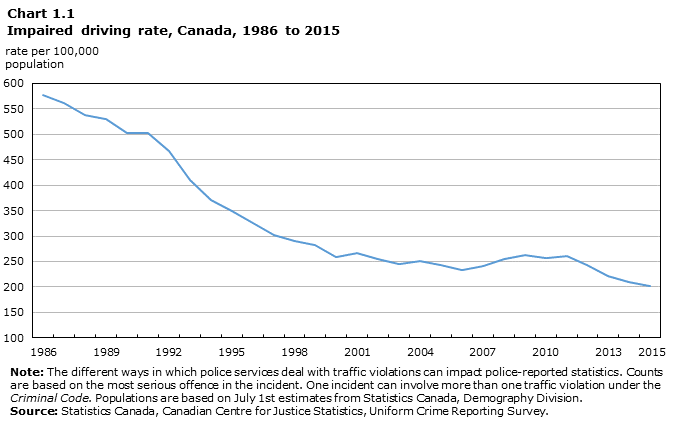
Description for Chart 1.1
| Year | Rate per 100,000 population |
|---|---|
| 1986 | 577 |
| 1987 | 561 |
| 1988 | 538 |
| 1989 | 529 |
| 1990 | 502 |
| 1991 | 502 |
| 1992 | 467 |
| 1993 | 410 |
| 1994 | 372 |
| 1995 | 349 |
| 1996 | 325 |
| 1997 | 301 |
| 1998 | 291 |
| 1999 | 283 |
| 2000 | 258 |
| 2001 | 267 |
| 2002 | 255 |
| 2003 | 245 |
| 2004 | 252 |
| 2005 | 243 |
| 2006 | 234 |
| 2007 | 241 |
| 2008 | 255 |
| 2009 | 263 |
| 2010 | 257 |
| 2011 | 261 |
| 2012 | 242 |
| 2013 | 221 |
| 2014 | 210 |
| 2015 | 201 |
|
Note: The different ways in which police services deal with traffic violations can impact police-reported statistics. Counts are based on the most serious offence in the incident. One incident can involve more than one traffic violation under the Criminal Code. Populations are based on July 1st estimates from Statistics Canada, Demography Division. Source: Statistics Canada, Canadian Centre for Justice Statistics, Uniform Crime Reporting Survey. |
|
Police reported 72,039 impaired driving incidents nationally, corresponding to a rate of 201 incidents per 100,000 population (Table 1.1). This rate is 4% lower than that reported in 2014 (210 per 100,000 population) and 65% lower than the rate reported in 1986 (577 per 100,000 population).
The impaired driving rate declined almost steadily from 1986 until the early 2000s. It then remained relatively stable, with slight fluctuations from time to time, until the start of the current decade when it renewed its downward trend.
It is important to note that the impaired driving rate can fluctuate as a result of a variety of factors and can be affected by enforcement practices such as impaired driving road side stop programs. Since most impaired driving incidents do not have a direct victim, detection may be influenced, more than other types of crimes, by law enforcement priorities and the allocation of police resources. Legislative changes and the attitudes of the public toward impaired driving can also have an impact.
Impaired driving causing death and impaired driving causing bodily harm are less likely to be affected by these factors, and they are more likely than other impaired driving incidents to systematically come to the attention of the police. For these offences, there has also been a substantial decline. In 2015, police reported 122 incidents of impaired driving causing death and 596 incidents of impaired driving causing bodily harm. In comparison, in 1986, police reported 196 and 1,581 of these incidents respectively. When the size of the population in those years is taken into consideration, these figures correspond to rate decreases of 55% and 73% respectively.
The number of incidents of impaired driving causing death and impaired driving causing bodily harm were also down from the previous year. In 2014, police reported 130 incidents causing death and 605 causing bodily harm.
Start of text box
Text box 2
History of certain Criminal Code amendments impacting impaired driving offences
1921: Parliament creates, under the Criminal Code, the summary conviction offence of driving while intoxicated.
1930: Parliament makes driving while intoxicated a hybrid offence, meaning it can proceed by summary or indictment.
1951: Parliament retains the driving while intoxicated offence and creates a hybrid offence of driving while impaired.
1969: The 1921 offence of driving while intoxicated is repealed. The offence of driving while impaired is retained and the "exceeds 80 mg of alcohol in 100 ml of blood" offence and the refusal to provide a breath sample on an "approved instrument" offence are added as summary conviction offences (hybridized in 1975).
1985: The prohibition of operating a vehicle while impaired is extended to aircraft and vessels. The maximum sentence is raised to 14 years where impaired operation causes death and to 10 years where it causes bodily harm. A mandatory driving prohibition period is introduced and some adjustments are made to penalties.
1999: Driving with a blood alcohol concentration exceeding 160 mg of alcohol per 100 ml of blood becomes an aggravating factor. Judges can now impose treatment or the use of an ignition interlock device. Driving prohibition periods are increased and the minimum fine for a first impaired driving offence is raised from $300 to $600.
2000: The maximum penalty for impaired driving causing death is increased to life imprisonment.
2008: The minimum fine for a first offence is raised from $600 to $1,000. The minimum penalty for a second offence goes from 14 days to 30 days and for a subsequent offence, from 90 days to 120 days. Moreover, police are now allowed to perform roadside tests and demand an assessment by an evaluating officer of drivers suspected of drug impairment.
Recent Supreme Court of Canada judgments
2012: R. v. St-Onge Lamoureux (2012 SCC 57). The legislation adopted by the federal government in 2008 had added new requirements related to the defence of persons charged with impaired driving. The purpose of those requirements was to limit the so-called “two beers” defence. That defence allowed the defendant to challenge the results of an approved device by calling an expert to assess the accused’s state of inebriation based on the number of alcoholic drinks he had consumed, his physical characteristics and the period of time over which he consumed the alcohol.
Beginning in 2008, the accused had to (a) demonstrate incorrect functioning or incorrect use of the device used to calculate the blood alcohol level, (b) demonstrate that the incorrect operation caused a reading above 80 mg/100 ml and (c) demonstrate evidence raising doubt that the blood alcohol level exceeded 80 mg/100 ml (the “two beers” defence). In November 2012, the Supreme Court ruled that only point (a) was a valid requirement. Also, consumption evidence alone is not sufficient to show incorrect functioning or incorrect use of an approved device.
2015: Goodwin v. British Columbia (Superintendent of Motor vehicles) (2015 SCC 46). In 2010, British Columbia added sections 215.41 to 215.51 to its Motor Vehicle Act. This legislation provided for an automatic licence suspension, a 90-day driving prohibition and the impoundment of the vehicle for persons failing a test or refusing a test using an approved screening device (ASD). These provincial provisions were challenged on the ground that they infringed criminal law. In its 2015 ruling, the Supreme Court of Canada unanimously upheld the validity of the provincial law.
End of text box
Increase in police-reported drug-impaired driving
In July 2008, provisions of the Criminal Code came into force enabling police to carry out compulsory roadside testing of drivers suspected of drug-impaired driving (see Text box 1).
In 2009, the first full year wherein these new provisions were enforced, police reported 1,455 drug-impaired driving incidents, which represented less than 2% of all impaired driving incidents for that year. By 2015, the number of drug-impaired driving incidents had almost doubled to 2,786 incidents or 4% of all impaired driving incidents.
It is difficult to know, however, whether this trend reflects an actual increase in the number of drug-impaired drivers or whether it is more a reflection of better detection and reporting by police.
Drug-impaired driving causing death or causing injury remained relatively stable during this period. In 2015, police reported 7 and 19 incidents respectively, numbers similar to the average reported between 2009 and 2014. In contrast, both alcohol-impaired driving causing death as well as that causing bodily harm declined during the same time period.
It should also be noted that some drivers stopped by police could have been impaired by both alcohol and drugs. In 2015, police reported that both alcohol and drug were involved in 519 impaired driving incidents. Since it is generally easier for police to lay charges for alcohol-impaired driving,Note 2 the majority of these cases (87%) were reported as such rather than as drug-impaired driving incidents.Note 3
Saskatchewan has the highest rate of police-reported impaired driving among the provinces
Saskatchewan recorded the highest impaired driving rate among the provinces in 2015, at 575 incidents per 100,000 population. This rate is considerably higher than that of any other province; Alberta ranked next with a rate of just over half that of Saskatchewan (314 per 100,000 population). However, impaired driving rates in two of the three Territories—Yukon and the Northwest Territories—were higher than that of Saskatchewan (Table 1.1 and Chart 1.2).
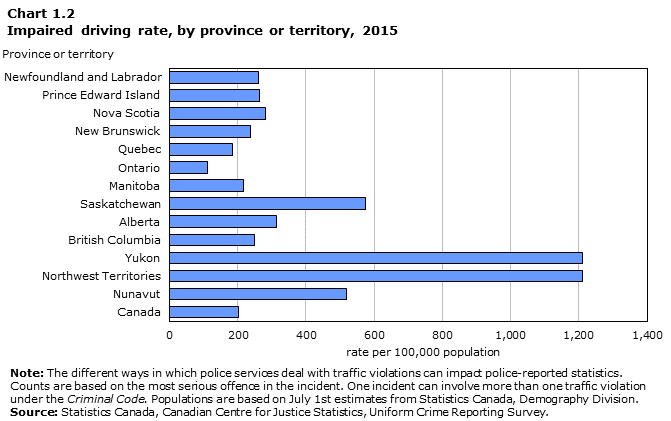
Description for Chart 1.2
| Province or territory | Rate per 100,000 population |
|---|---|
| Canada | 201 |
| Nunavut | 520 |
| Northwest Territories | 1,211 |
| Yukon | 1,210 |
| British Columbia | 249 |
| Alberta | 314 |
| Saskatchewan | 575 |
| Manitoba | 217 |
| Ontario | 111 |
| Quebec | 184 |
| New Brunswick | 238 |
| Nova Scotia | 281 |
| Prince Edward Island | 264 |
| Newfoundland and Labrador | 261 |
|
Note: The different ways in which police services deal with traffic violations can impact police-reported statistics. Counts are based on the most serious offence in the incident. One incident can involve more than one traffic violation under the Criminal Code. Populations are based on July 1st estimates from Statistics Canada, Demography Division. Source: Statistics Canada, Canadian Centre for Justice Statistics, Uniform Crime Reporting Survey. |
|
Over the past 30 years, all provinces have seen substantial decreases in their impaired driving rates. Prince Edward Island, Ontario, Alberta and Manitoba have experienced the most notable decreases during this period with all of their rates having fallen close to 75%. In contrast, Saskatchewan has seen the smallest decline (-37%).
In all provinces, most of the decrease in the impaired driving rate occurred before the 2000s. Trends thereafter varied depending on the province, with some experiencing slight increases and others slight declines. However, impaired driving rates have fallen in all provinces over the last three years.
The portrait is somewhat different in the territories. In Northwest Territories and Nunavut, the impaired driving rate increased sharply from early 2000s to late 2000s. Similar to the provinces, a downward trend has been observed in recent years. The Yukon has, in general, experienced a trend similar to that observed in the provinces, however the impaired driving rate has increased since the beginning of the decade. It should be noted that differences between provinces and territories as well as changes over time may be influenced by the various measures taken by the provinces and territories to combat impaired driving as well as by law enforcement practices.
Newfoundland and Labrador record the highest rate of police-reported drug-impaired driving among the provinces
While Saskatchewan had, overall, the highest rate of impaired driving among the provinces in 2015, the portrait was somewhat different in the case of drug-impaired driving specifically. The Atlantic provinces recorded the highest rates of drug-impaired driving, with Newfoundland and Labrador (22.9 incidents per 100,000 population) having the highest rate, followed by Nova Scotia (20.7 per 100,000) and Prince Edward Island (15.0). Still, these rates were lower than those recorded by any of the three territories (Chart 1.3).
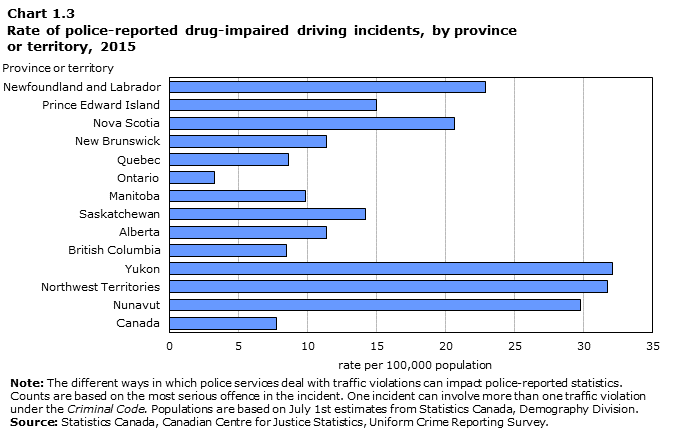
Description for Chart 1.3
| Province or territory | Rate per 100,000 population |
|---|---|
| Canada | 8 |
| Nunavut | 30 |
| Northwest Territories | 32 |
| Yukon | 32 |
| British Columbia | 8 |
| Alberta | 11 |
| Saskatchewan | 14 |
| Manitoba | 10 |
| Ontario | 3 |
| Quebec | 9 |
| New Brunswick | 11 |
| Nova Scotia | 21 |
| Prince Edward Island | 15 |
| Newfoundland and Labrador | 23 |
|
Note: The different ways in which police services deal with traffic violations can impact police-reported statistics. Counts are based on the most serious offence in the incident. One incident can involve more than one traffic violation under the Criminal Code. Populations are based on July 1st estimates from Statistics Canada, Demography Division. Source: Statistics Canada, Canadian Centre for Justice Statistics, Uniform Crime Reporting Survey. |
|
In contrast, Ontario posted by far the lowest rate of drug-impaired driving among all provinces and territories in 2015, with 3.2 incidents per 100,000 population. British Columbia was next (8.5 per 100,000 population), followed by Quebec (8.6). Ontario is the only province to record a drug-impaired driving rate below the national average (7.8 per 100,000 population).
Start of text box
Text box 3
Drug Evaluation and Classification Program
“The Drug Evaluation and Classification Program (DEC) was founded in Los Angeles in the 1970s [...] The LAPD used Standardized Field Sobriety tests in conjunction with accepted medical knowledge to devise a step-by-step procedure to enable them to determine drug influence. When a person is suspected of drug use, they are evaluated based on seven drug categories (central nervous system (CNS) depressants, inhalants, dissociative anaesthetics, cannabis, CNS stimulants, hallucinogens and narcotic analgesics). During the evaluation the drug recognition expert (DRE) must also determine if the person may be suffering from another condition which may cause signs of impairment (illness, fatigue, mental condition, etc.).
The DRE program was introduced in British Columbia in October 1995 with the first national course being delivered in January 2003. The program received legislative support in July 2008 when changes to the Criminal Code came into force making the drug evaluation compulsory by way of a demand. The legislation calls for drivers to submit to standardized field sobriety tests (psycho-physical coordination tests) which are performed on the road side. If there is evidence of impairment, the driver must accompany the officer to the police station for further evaluation of drug influence by an officer trained in the DRE program.” (Royal Canadian Mounted Police 2016a).
End of text box
Proportionally fewer police-reported impaired-driving incidents in CMAs than outside CMAs
In 2015, there were fewer impaired driving incidents overall in census metropolitan areas (CMAs) relative to the size of their population; this was especially true for the most serious incidents.
About 7 in 10 Canadians live in one of the country’s 33 CMAs. These areas, however, accounted for half (50%) of all impaired driving incidents reported by police. This observation applies equally to alcohol-impaired driving (50%) and drug-impaired driving (51%).
This difference was even more significant in the case of impaired driving causing death, with less than one-third (31%) of these incidents occurring in a CMA. Looking at the three most populated CMAs, in particular—Toronto, Montréal and Vancouver—only 8% of impaired driving incidents causing death were reported in these three CMAs, although they account for 35% of the Canadian population.
The generally lower impaired driving rates reported by police in CMAs might be explained in part by a number of factors. In particular, there are proportionally fewer households with a vehicle in CMAs than outside these areas.Note 4 In addition, the distances to travel in rural settings are generally longer such that impaired drivers are on the road longer and the risk of incidents is higher. The availability of alternative transportation may also be more limited outside CMAs (Robertson et al. 2016; Paré and Larochelle 2004). Lastly, when it comes to drug-impaired driving specifically, the availability of evaluating officers (DRE) may be more limited in some rural areas than in CMAs (Asbridge and Ogilvie 2015).
St. John’s posts the highest impaired driving rate among CMAs
Among CMAs, St. John’s had the highest impaired driving rate in 2015, with 411 incidents per 100,000 population. The CMAs of Kelowna and Regina followed with rates of 323 and 311 police-reported impaired driving incidents per 100,000 population respectively (Table 1.2 and Chart 1.4).
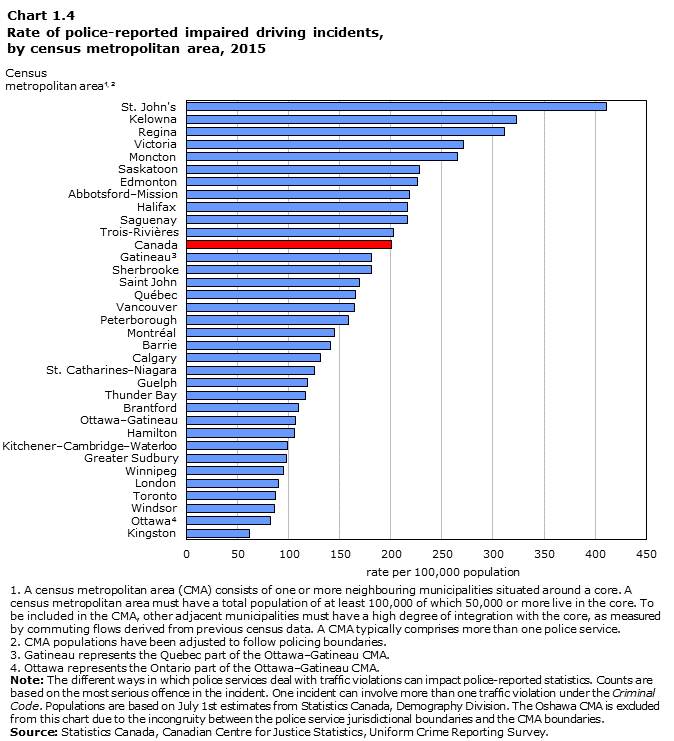
Description for Chart 1.4
| Census metropolitan areaData table Note 1, Data table Note 2 | Rate per 100,000 population |
|---|---|
| Kingston | 62 |
| OttawaData table Note 4 | 82 |
| Windsor | 86 |
| Toronto | 87 |
| London | 90 |
| Winnipeg | 95 |
| Greater Sudbury | 98 |
| Kitchener–Cambridge–Waterloo | 99 |
| Hamilton | 106 |
| Ottawa–Gatineau | 107 |
| Brantford | 109 |
| Thunder Bay | 116 |
| Guelph | 118 |
| St. Catharines–Niagara | 126 |
| Calgary | 132 |
| Barrie | 141 |
| Montréal | 145 |
| Peterborough | 159 |
| Vancouver | 164 |
| Québec | 165 |
| Saint John | 170 |
| Sherbrooke | 181 |
| GatineauData table Note 3 | 181 |
| Canada | 201 |
| Trois-Rivières | 203 |
| Saguenay | 217 |
| Halifax | 217 |
| Abbotsford–Mission | 218 |
| Edmonton | 226 |
| Saskatoon | 228 |
| Moncton | 266 |
| Victoria | 271 |
| Regina | 311 |
| Kelowna | 323 |
| St. John's | 411 |
Source: Statistics Canada, Canadian Centre for Justice Statistics, Uniform Crime Reporting Survey. |
|
In contrast, the Kingston CMA recorded the lowest rate at 62 impaired driving incidents per 100,000 population. It was followed by Ottawa (82 per 100,000 population) and Windsor (86 per 100,000 population). Most Ontario CMAs, with the exception of Hamilton (+21%) and St. Catharines–Niagara (-6%), have recorded a decrease in their rates of at least 10% over the past decade.
The differences between CMAs were particularly large for drug-impaired driving. While some CMAs reported no incidents in 2015 (Brantford, St. Catharines–Niagara), St. John’s recorded 88, a rate of 42.8 per 100,000 population. As with differences between provinces, differences between CMAs may be due to different police practices.
The proportion of impaired driving incidents cleared by charge is on the decline
Fewer impaired driving incidents are resulting in a Criminal Code charge. In 1998, almost 9 out of 10 impaired driving incidents (89%) were cleared by charge. In 2015, the proportion was 71% and had remained relatively the same for the previous four years.
There are a number of reasons why police may choose not to lay criminal charges, for example, if different blood alcohol readings give contradictory results, or if police had to interrupt the intervention to respond to a more urgent call. In certain cases, police may choose to deal with the incident under provincial laws. For example, British Columbia adopted amendments to its Motor Vehicle Act in September 2010 that allow for the immediate suspension of the licence of a driver suspected of driving with a blood alcohol level above 80 mg/100 ml. In British Columbia, the clearance rate by charge under the Criminal Code fell from 69% in 2009 to 27% in 2011.
Drug-impaired driving is less likely to result in a charge than alcohol-impaired driving
In 2015, police-reported incidents of drug-impaired driving were less likely to be cleared by chargeNote 5 than incidents of alcohol-impaired driving. Of the 2,786 drug-impaired driving incidents reported by police in 2015, 1,633, or 59%, were cleared by charge. In comparison, 71% of alcohol-impaired driving incidents were cleared by charge (Chart 1.5).
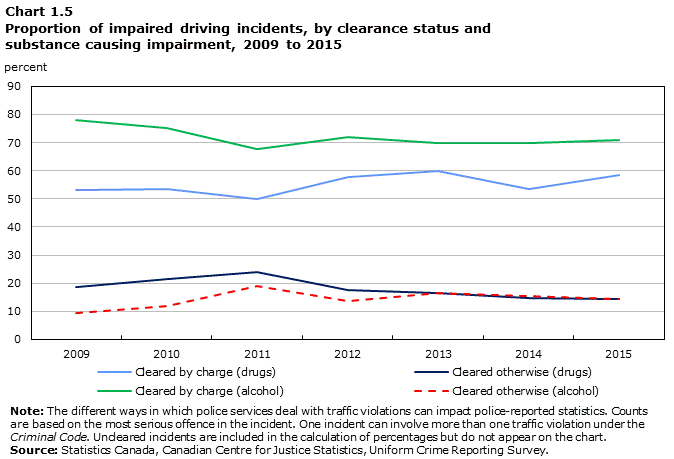
Description for Chart 1.5
| Clearance status | 2009 | 2010 | 2011 | 2012 | 2013 | 2014 | 2015 |
|---|---|---|---|---|---|---|---|
| percent | |||||||
| Cleared by charge (drugs) | 53.0 | 53.4 | 50.0 | 57.7 | 59.7 | 53.5 | 58.6 |
| Cleared otherwise (drugs) | 18.6 | 21.3 | 23.9 | 17.6 | 16.6 | 14.9 | 14.2 |
| Cleared by charge (alcohol) | 78.0 | 75.2 | 67.6 | 71.9 | 70.0 | 69.9 | 71.0 |
| Cleared otherwise (alcohol) | 9.2 | 11.9 | 18.9 | 13.8 | 16.4 | 15.4 | 14.3 |
|
Note: The different ways in which police services deal with traffic violations can impact police-reported statistics. Counts are based on the most serious offence in the incident. One incident can involve more than one traffic violation under the Criminal Code. Uncleared incidents are included in the calculation of percentages but do not appear on the chart. Source: Statistics Canada, Canadian Centre for Justice Statistics, Uniform Crime Reporting Survey. |
|||||||
This difference may be due in part to the different rules and evidentiary requirements as well as to the different means of detection used, depending on the intoxicating substance. Alcohol has a clear limit: 80 mg/100 ml, established by section 253(b) of the Criminal Code. Police also use a relatively simple and reliable screening device, called an approved screening device (ASD) (breathalyzer).
In contrast, there is no limit set out in the Criminal Code for the level of drug intoxication that impairs driving ability, and there is no screening device capable of precisely measuring drug-impairment. To determine, therefore, whether drivers are drug-impaired, they are required to undergo a coordination test. If they fail, they would have to be evaluated at the police station by a drug recognition expert (DRE) and undergo a bodily fluid sample for analysis. A driver would then be charged under section 253(a) of the Criminal Code.
Of note, the Drug Evaluation and Classification Program, which includes DREs, has only been in place since 2008. It may be that charge rates will increase as the system matures. Between 2009 and 2015, the proportion of drug-impaired driving incidents resulting in a charge rose from 53% to 59%. During the same period, the proportion of alcohol-impaired driving incidents resulting in a charge fell from 78% to 71%.
Drug-impaired driving incidents take longer to be cleared than alcohol-impaired incidents
Another sign that drug-impaired driving incidents can be more complex to investigate than alcohol-impaired driving incidents is that they generally take longer to be cleared by police.
In 2015, the majority of police-reported impaired driving cleared incidents, whether alcohol- or drug-related, had been cleared in a day or less. However, over one-quarter (28%) of drug-impaired driving incidents required more than 30 days to be cleared. In comparison, this was the case for 16% of alcohol-impaired driving incidents.
The majority of people charged with impaired driving are male, but the female proportion is on the rise
As with most criminal offences, the majority of persons charged with impaired driving are men. Among those charged with impaired driving in 2015, roughly four out of five (80%) were males. This proportion was similar for both alcohol- and drug-impaired driving.
However, the proportion of females among those charged with impaired driving has been rising steadily since data were first collected. In 1986, 8% of persons charged with impaired driving were female, compared with 20% in 2015. Therefore, while the number of incidents of impaired driving has decreased by more than half since 1986, the number of female impaired drivers has remained relatively stable.
Drivers under 20 years of age had the largest decline in the rate of police-reported impaired driving
Young adults are more likely than drivers in other age groups to be accused of impaired driving. In 2015, the highest rate was observed among drivers aged 20 to 24, at 480 incidents per 100,000 drivers.Note 6 However, this rate was 36% lower than the rate recorded in 2009 (751 per 100,000), one of the largest declines recorded among all age groups (Chart 1.6). The largest decline was observed for drivers aged 16 to 19. Their rate fell from 517 incidents per 100,000 drivers in 2009 to 210 incidents per 100,000 in 2015, a drop of 59%.
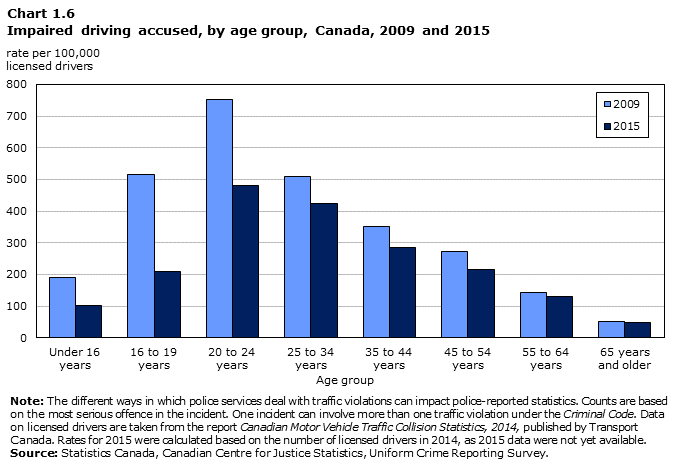
Description for Chart 1.6
| Age group | 2009 | 2015 |
|---|---|---|
| rate per 100,000 licensed drivers | ||
| Under 16 years |
191 | 100 |
| 16 to 19 years |
517 | 210 |
| 20 to 24 years |
751 | 480 |
| 25 to 34 years |
511 | 425 |
| 35 to 44 years |
352 | 284 |
| 45 to 54 years |
271 | 216 |
| 55 to 64 years |
144 | 131 |
| 65 years and older |
53 | 48 |
|
Note: The different ways in which police services deal with traffic violations can impact police-reported statistics. Counts are based on the most serious offence in the incident. One incident can involve more than one traffic violation under the Criminal Code. Data on licensed drivers are taken from the report Canadian Motor Vehicle Traffic Collision Statistics, 2014, published by Transport Canada. Rates for 2015 were calculated based on the number of licensed drivers in 2014, as 2015 data were not yet available. Source: Statistics Canada, Canadian Centre for Justice Statistics, Uniform Crime Reporting Survey. |
||
It should be noted that all provinces and territories, except Nunavut, have a zero tolerance approach to drinking and driving for new drivers, which could have influenced the trends for these age groups. Some provinces, including Ontario, Quebec, New Brunswick and Saskatchewan, recently extended this zero tolerance to all young drivers, whether or not they are new drivers. Quebec and New Brunswick are the two provinces where the number of impaired driving incidents for drivers under 20 years of age decreased the most between 2009 and 2015.
As with impaired driving overall, drug-impaired driving peaks among young adults, with a rate of 17 incidents per 100,000 drivers aged 20 to 24. Between 2009 and 2015, the rate of drug-impaired driving rose among drivers of all ages, the largest increases being observed among drivers aged 55 to 64 (+114%) and those aged 25 to 34 (+89%) (Chart 1.7).
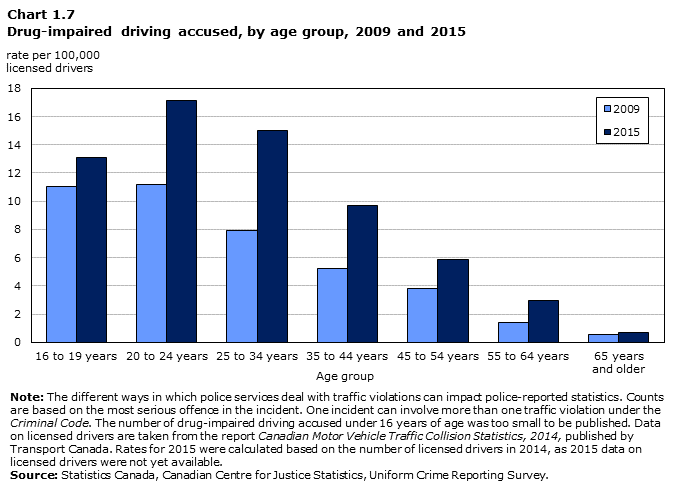
Description for Chart 1.7
| Age group | 2009 | 2015 |
|---|---|---|
| rate per 100,000 licensed drivers | ||
| 16 to 19 years | 11 | 13 |
| 20 to 24 years | 11 | 17 |
| 25 to 34 years | 8 | 15 |
| 35 to 44 years | 5 | 10 |
| 45 to 54 years | 4 | 6 |
| 55 to 64 years | 1 | 3 |
| 65 years and older | 1 | 1 |
|
Note: The different ways in which police services deal with traffic violations can impact police-reported statistics. Counts are based on the most serious offence in the incident. One incident can involve more than one traffic violation under the Criminal Code. The number of drug-impaired driving accused under 16 years of age was too small to be published. Data on licensed drivers are taken from the report Canadian Motor Vehicle Traffic Collision Statistics, 2014, published by Transport Canada. Rates for 2015 were calculated based on the number of licensed drivers in 2014, as 2015 data on licensed drivers were not yet available. Source: Statistics Canada, Canadian Centre for Justice Statistics, Uniform Crime Reporting Survey. |
||
About half of all impaired driving incidents occur on the weekend
Incidents of impaired driving are more likely to occur on a weekendNote 7 than on any other day of the week. In 2015, one-quarter (25%) of incidents occurred on a Saturday with almost as many (21%) occurring on a Sunday (Chart 1.8).
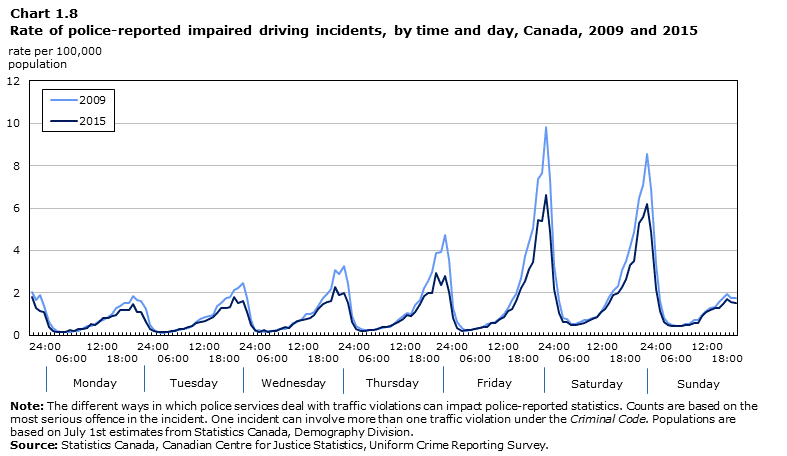
Description for Chart 1.8
| Days | Hours | 2009 | 2015 |
|---|---|---|---|
| rate per 100,000 population | |||
| Monday | 12 a.m. | 2.0 | 1.8 |
| 1 | 1.6 | 1.3 | |
| 2 | 1.9 | 1.2 | |
| 3 | 1.4 | 1.1 | |
| 4 | 0.6 | 0.4 | |
| 5 | 0.3 | 0.2 | |
| 6 | 0.2 | 0.2 | |
| 7 | 0.2 | 0.2 | |
| 8 | 0.1 | 0.2 | |
| 9 | 0.2 | 0.2 | |
| 10 | 0.2 | 0.2 | |
| 11 | 0.2 | 0.3 | |
| 12 p.m. | 0.3 | 0.3 | |
| 13 | 0.4 | 0.3 | |
| 14 | 0.4 | 0.5 | |
| 15 | 0.5 | 0.5 | |
| 16 | 0.7 | 0.6 | |
| 17 | 0.7 | 0.8 | |
| 18 | 0.9 | 0.8 | |
| 19 | 1.0 | 0.9 | |
| 20 | 1.3 | 0.9 | |
| 21 | 1.4 | 1.2 | |
| 22 | 1.5 | 1.2 | |
| 23 | 1.5 | 1.2 | |
| Tuesday | 12 a.m. | 1.8 | 1.5 |
| 1 | 1.6 | 1.1 | |
| 2 | 1.6 | 1.1 | |
| 3 | 1.2 | 0.6 | |
| 4 | 0.5 | 0.3 | |
| 5 | 0.2 | 0.2 | |
| 6 | 0.2 | 0.1 | |
| 7 | 0.1 | 0.2 | |
| 8 | 0.1 | 0.2 | |
| 9 | 0.2 | 0.2 | |
| 10 | 0.2 | 0.2 | |
| 11 | 0.2 | 0.3 | |
| 12 p.m. | 0.3 | 0.3 | |
| 13 | 0.4 | 0.4 | |
| 14 | 0.4 | 0.4 | |
| 15 | 0.6 | 0.6 | |
| 16 | 0.8 | 0.6 | |
| 17 | 0.9 | 0.7 | |
| 18 | 0.9 | 0.8 | |
| 19 | 0.9 | 0.9 | |
| 20 | 1.4 | 1.1 | |
| 21 | 1.5 | 1.3 | |
| 22 | 1.7 | 1.3 | |
| 23 | 1.8 | 1.3 | |
| Wednesday | 12 a.m. | 2.2 | 1.8 |
| 1 | 2.2 | 1.5 | |
| 2 | 2.5 | 1.6 | |
| 3 | 1.8 | 1.1 | |
| 4 | 0.7 | 0.5 | |
| 5 | 0.2 | 0.3 | |
| 6 | 0.2 | 0.2 | |
| 7 | 0.2 | 0.2 | |
| 8 | 0.2 | 0.2 | |
| 9 | 0.2 | 0.2 | |
| 10 | 0.3 | 0.2 | |
| 11 | 0.3 | 0.3 | |
| 12 p.m. | 0.3 | 0.4 | |
| 13 | 0.4 | 0.4 | |
| 14 | 0.6 | 0.5 | |
| 15 | 0.6 | 0.7 | |
| 16 | 0.8 | 0.7 | |
| 17 | 1.0 | 0.7 | |
| 18 | 1.0 | 0.8 | |
| 19 | 1.1 | 1.0 | |
| 20 | 1.4 | 1.2 | |
| 21 | 1.8 | 1.5 | |
| 22 | 2.0 | 1.5 | |
| 23 | 2.2 | 1.6 | |
| Thursday | 12 a.m. | 3.1 | 2.3 |
| 1 | 2.9 | 1.9 | |
| 2 | 3.3 | 2.0 | |
| 3 | 2.4 | 1.5 | |
| 4 | 0.9 | 0.6 | |
| 5 | 0.4 | 0.3 | |
| 6 | 0.3 | 0.2 | |
| 7 | 0.3 | 0.2 | |
| 8 | 0.3 | 0.3 | |
| 9 | 0.3 | 0.2 | |
| 10 | 0.3 | 0.3 | |
| 11 | 0.4 | 0.4 | |
| 12 p.m. | 0.4 | 0.4 | |
| 13 | 0.4 | 0.4 | |
| 14 | 0.5 | 0.5 | |
| 15 | 0.7 | 0.6 | |
| 16 | 0.9 | 0.7 | |
| 17 | 1.0 | 0.9 | |
| 18 | 1.0 | 0.9 | |
| 19 | 1.5 | 1.1 | |
| 20 | 1.7 | 1.5 | |
| 21 | 2.2 | 1.9 | |
| 22 | 2.6 | 2.0 | |
| 23 | 3.0 | 2.0 | |
| Friday | 12 a.m. | 3.9 | 2.9 |
| 1 | 3.9 | 2.4 | |
| 2 | 4.8 | 2.8 | |
| 3 | 3.6 | 2.0 | |
| 4 | 1.3 | 0.8 | |
| 5 | 0.6 | 0.3 | |
| 6 | 0.3 | 0.2 | |
| 7 | 0.2 | 0.3 | |
| 8 | 0.2 | 0.3 | |
| 9 | 0.3 | 0.3 | |
| 10 | 0.3 | 0.3 | |
| 11 | 0.4 | 0.4 | |
| 12 p.m. | 0.5 | 0.4 | |
| 13 | 0.6 | 0.6 | |
| 14 | 0.6 | 0.6 | |
| 15 | 0.8 | 0.8 | |
| 16 | 1.0 | 0.9 | |
| 17 | 1.3 | 1.2 | |
| 18 | 1.7 | 1.2 | |
| 19 | 2.0 | 1.6 | |
| 20 | 2.7 | 2.2 | |
| 21 | 3.8 | 2.6 | |
| 22 | 4.4 | 3.1 | |
| 23 | 5.1 | 3.5 | |
| Saturday | 12 a.m. | 7.4 | 5.4 |
| 1 | 7.7 | 5.4 | |
| 2 | 9.8 | 6.6 | |
| 3 | 7.3 | 4.9 | |
| 4 | 3.3 | 2.2 | |
| 5 | 1.6 | 1.1 | |
| 6 | 0.8 | 0.6 | |
| 7 | 0.8 | 0.6 | |
| 8 | 0.5 | 0.5 | |
| 9 | 0.6 | 0.5 | |
| 10 | 0.6 | 0.5 | |
| 11 | 0.7 | 0.6 | |
| 12 p.m. | 0.7 | 0.7 | |
| 13 | 0.8 | 0.8 | |
| 14 | 0.9 | 0.9 | |
| 15 | 1.1 | 1.1 | |
| 16 | 1.4 | 1.3 | |
| 17 | 1.8 | 1.5 | |
| 18 | 2.1 | 1.9 | |
| 19 | 2.3 | 2.0 | |
| 20 | 3.1 | 2.3 | |
| 21 | 3.5 | 2.7 | |
| 22 | 4.2 | 3.3 | |
| 23 | 4.9 | 3.5 | |
| Sunday | 12 a.m. | 6.5 | 5.3 |
| 1 | 7.1 | 5.6 | |
| 2 | 8.6 | 6.2 | |
| 3 | 6.9 | 4.9 | |
| 4 | 3.4 | 2.2 | |
| 5 | 1.6 | 1.1 | |
| 6 | 0.8 | 0.6 | |
| 7 | 0.6 | 0.5 | |
| 8 | 0.5 | 0.5 | |
| 9 | 0.4 | 0.4 | |
| 10 | 0.4 | 0.4 | |
| 11 | 0.6 | 0.5 | |
| 12 p.m. | 0.5 | 0.5 | |
| 13 | 0.7 | 0.6 | |
| 14 | 0.7 | 0.6 | |
| 15 | 1.0 | 0.9 | |
| 16 | 1.1 | 1.1 | |
| 17 | 1.3 | 1.2 | |
| 18 | 1.3 | 1.3 | |
| 19 | 1.6 | 1.3 | |
| 20 | 1.7 | 1.5 | |
| 21 | 1.9 | 1.7 | |
| 22 | 1.8 | 1.6 | |
| 23 | 1.8 | 1.5 | |
|
Note: The different ways in which police services deal with traffic violations can impact police-reported statistics. Counts are based on the most serious offence in the incident. One incident can involve more than one traffic violation under the Criminal Code. Populations are based on July 1st estimates from Statistics Canada, Demography Division. Source: Statistics Canada, Canadian Centre for Justice Statistics, Uniform Crime Reporting Survey. |
|||
Overall, impaired driving peaks between 2:00 a.m. and 3:00 a.m. However, this peak is primarily attributable to incidents occurring on weekends (from Friday night to Saturday and Saturday night to Sunday). During the week, impaired driving incidents are most likely to occur between midnight and 1:00 a.m. When all days are considered, almost half of all police-reported impaired driving incidents in 2015 occurred between 11:00 p.m. and 4:00 a.m.
While the majority of police-reported impaired driving incidents occurred at night, this is also the period when most of the decrease in impaired driving was observed. In 2015, police reported almost 11,000 fewer incidents of impaired driving than in 2009 for the period between 11:00 p.m. and 4:00 a.m., accounting for 69% of the overall decline in impaired driving since 2009.
While the peak hour for impaired driving in 2009 was between 2:00 a.m. and 3:00 a.m. for almost every day of the week, however this was the case only for Saturdays and Sundays in 2015. On the other days, the peak shifted between midnight to 1:00 a.m.
Police-reported drug-impaired driving fluctuates only slightly by time or the day of the week
Compared with alcohol-impaired driving, the number of drug-impaired driving incidents varied much less by time or the day of the week, as was also noted in a previous study by Beirness and Beasley, 2011.
As was the case for alcohol-impaired driving, Saturday (18%) is the day that the most incidents of drug-impaired driving were reported. However, less than one-third (32%) of drug-impaired driving incidents occurred on weekends in 2015, compared with almost half (47%) of alcohol-impaired driving incidents (Chart 1.9).
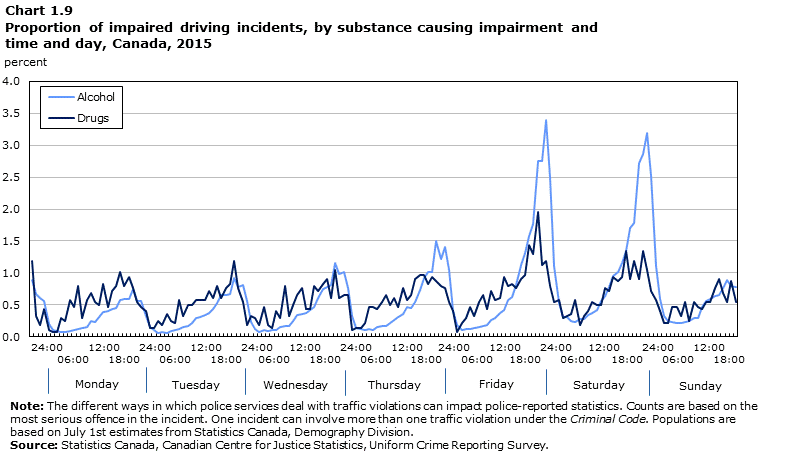
Description for Chart 1.9
| Days | Hours | Alcohol | Drugs |
|---|---|---|---|
| percent | |||
| Monday | 12 a.m. | 0.9 | 1.2 |
| 1 | 0.7 | 0.3 | |
| 2 | 0.6 | 0.2 | |
| 3 | 0.6 | 0.4 | |
| 4 | 0.2 | 0.1 | |
| 5 | 0.1 | 0.1 | |
| 6 | 0.1 | 0.1 | |
| 7 | 0.1 | 0.3 | |
| 8 | 0.1 | 0.3 | |
| 9 | 0.1 | 0.6 | |
| 10 | 0.1 | 0.5 | |
| 11 | 0.1 | 0.8 | |
| 12 p.m. | 0.1 | 0.3 | |
| 13 | 0.2 | 0.6 | |
| 14 | 0.3 | 0.7 | |
| 15 | 0.2 | 0.5 | |
| 16 | 0.3 | 0.5 | |
| 17 | 0.4 | 0.8 | |
| 18 | 0.4 | 0.5 | |
| 19 | 0.4 | 0.7 | |
| 20 | 0.5 | 0.8 | |
| 21 | 0.6 | 1.0 | |
| 22 | 0.6 | 0.8 | |
| 23 | 0.6 | 0.9 | |
| Tuesday | 12 a.m. | 0.7 | 0.8 |
| 1 | 0.6 | 0.5 | |
| 2 | 0.6 | 0.5 | |
| 3 | 0.3 | 0.4 | |
| 4 | 0.2 | 0.1 | |
| 5 | 0.1 | 0.1 | |
| 6 | 0.1 | 0.3 | |
| 7 | 0.1 | 0.2 | |
| 8 | 0.1 | 0.4 | |
| 9 | 0.1 | 0.3 | |
| 10 | 0.1 | 0.2 | |
| 11 | 0.1 | 0.6 | |
| 12 p.m. | 0.1 | 0.3 | |
| 13 | 0.2 | 0.5 | |
| 14 | 0.2 | 0.5 | |
| 15 | 0.3 | 0.6 | |
| 16 | 0.3 | 0.6 | |
| 17 | 0.3 | 0.6 | |
| 18 | 0.4 | 0.7 | |
| 19 | 0.4 | 0.6 | |
| 20 | 0.5 | 0.8 | |
| 21 | 0.7 | 0.6 | |
| 22 | 0.6 | 0.8 | |
| 23 | 0.7 | 0.8 | |
| Wednesday | 12 a.m. | 0.9 | 1.2 |
| 1 | 0.8 | 0.8 | |
| 2 | 0.8 | 0.5 | |
| 3 | 0.6 | 0.2 | |
| 4 | 0.2 | 0.3 | |
| 5 | 0.1 | 0.3 | |
| 6 | 0.1 | 0.2 | |
| 7 | 0.1 | 0.5 | |
| 8 | 0.1 | 0.2 | |
| 9 | 0.1 | 0.1 | |
| 10 | 0.1 | 0.4 | |
| 11 | 0.2 | 0.3 | |
| 12 p.m. | 0.2 | 0.8 | |
| 13 | 0.2 | 0.3 | |
| 14 | 0.3 | 0.5 | |
| 15 | 0.3 | 0.6 | |
| 16 | 0.3 | 0.8 | |
| 17 | 0.4 | 0.4 | |
| 18 | 0.4 | 0.4 | |
| 19 | 0.5 | 0.8 | |
| 20 | 0.6 | 0.7 | |
| 21 | 0.7 | 0.8 | |
| 22 | 0.8 | 0.9 | |
| 23 | 0.8 | 0.6 | |
| Thursday | 12 a.m. | 1.1 | 1.0 |
| 1 | 1.0 | 0.6 | |
| 2 | 1.0 | 0.6 | |
| 3 | 0.8 | 0.6 | |
| 4 | 0.3 | 0.1 | |
| 5 | 0.1 | 0.1 | |
| 6 | 0.1 | 0.1 | |
| 7 | 0.1 | 0.2 | |
| 8 | 0.1 | 0.5 | |
| 9 | 0.1 | 0.5 | |
| 10 | 0.1 | 0.4 | |
| 11 | 0.2 | 0.5 | |
| 12 p.m. | 0.2 | 0.6 | |
| 13 | 0.2 | 0.5 | |
| 14 | 0.3 | 0.6 | |
| 15 | 0.3 | 0.5 | |
| 16 | 0.4 | 0.8 | |
| 17 | 0.5 | 0.6 | |
| 18 | 0.4 | 0.6 | |
| 19 | 0.5 | 0.9 | |
| 20 | 0.7 | 1.0 | |
| 21 | 0.9 | 1.0 | |
| 22 | 1.0 | 0.8 | |
| 23 | 1.0 | 0.9 | |
| Friday | 12 a.m. | 1.5 | 0.9 |
| 1 | 1.2 | 0.8 | |
| 2 | 1.4 | 0.8 | |
| 3 | 1.0 | 0.5 | |
| 4 | 0.4 | 0.4 | |
| 5 | 0.2 | 0.1 | |
| 6 | 0.1 | 0.2 | |
| 7 | 0.1 | 0.3 | |
| 8 | 0.1 | 0.5 | |
| 9 | 0.1 | 0.3 | |
| 10 | 0.2 | 0.5 | |
| 11 | 0.2 | 0.6 | |
| 12 p.m. | 0.2 | 0.4 | |
| 13 | 0.3 | 0.7 | |
| 14 | 0.3 | 0.6 | |
| 15 | 0.4 | 0.6 | |
| 16 | 0.4 | 0.9 | |
| 17 | 0.6 | 0.8 | |
| 18 | 0.6 | 0.8 | |
| 19 | 0.8 | 0.8 | |
| 20 | 1.1 | 0.9 | |
| 21 | 1.3 | 1.0 | |
| 22 | 1.6 | 1.4 | |
| 23 | 1.8 | 1.3 | |
| Saturday | 12 a.m. | 2.7 | 1.9 |
| 1 | 2.8 | 1.1 | |
| 2 | 3.4 | 1.2 | |
| 3 | 2.5 | 0.8 | |
| 4 | 1.1 | 0.5 | |
| 5 | 0.5 | 0.6 | |
| 6 | 0.3 | 0.3 | |
| 7 | 0.3 | 0.3 | |
| 8 | 0.3 | 0.4 | |
| 9 | 0.2 | 0.6 | |
| 10 | 0.3 | 0.2 | |
| 11 | 0.3 | 0.3 | |
| 12 p.m. | 0.3 | 0.4 | |
| 13 | 0.4 | 0.5 | |
| 14 | 0.4 | 0.5 | |
| 15 | 0.6 | 0.5 | |
| 16 | 0.6 | 0.8 | |
| 17 | 0.8 | 0.7 | |
| 18 | 0.9 | 0.9 | |
| 19 | 1.0 | 0.9 | |
| 20 | 1.2 | 0.9 | |
| 21 | 1.3 | 1.3 | |
| 22 | 1.7 | 0.9 | |
| 23 | 1.8 | 1.2 | |
| Sunday | 12 a.m. | 2.7 | 0.9 |
| 1 | 2.9 | 1.3 | |
| 2 | 3.2 | 1.0 | |
| 3 | 2.5 | 0.7 | |
| 4 | 1.1 | 0.6 | |
| 5 | 0.6 | 0.4 | |
| 6 | 0.3 | 0.2 | |
| 7 | 0.2 | 0.2 | |
| 8 | 0.2 | 0.5 | |
| 9 | 0.2 | 0.5 | |
| 10 | 0.2 | 0.3 | |
| 11 | 0.2 | 0.5 | |
| 12 p.m. | 0.3 | 0.3 | |
| 13 | 0.3 | 0.5 | |
| 14 | 0.3 | 0.5 | |
| 15 | 0.5 | 0.4 | |
| 16 | 0.6 | 0.5 | |
| 17 | 0.6 | 0.5 | |
| 18 | 0.6 | 0.8 | |
| 19 | 0.7 | 0.9 | |
| 20 | 0.8 | 0.7 | |
| 21 | 0.9 | 0.5 | |
| 22 | 0.8 | 0.9 | |
| 23 | 0.8 | 0.5 | |
|
Note: The different ways in which police services deal with traffic violations can impact police-reported statistics. Counts are based on the most serious offence in the incident. One incident can involve more than one traffic violation under the Criminal Code. Populations are based on July 1st estimates from Statistics Canada, Demography Division. Source: Statistics Canada, Canadian Centre for Justice Statistics, Uniform Crime Reporting Survey. |
|||
The same tendency is seen for the time at which drug-impaired driving incidents are reported. While almost half (47%) of alcohol-impaired driving incidents were reported between 11:00 p.m. and 4:00 a.m., this was the case for only 28% of drug-impaired driving incidents, about the same proportion as between 6:00 p.m. and 11:00 p.m.
What this suggests is that drug-impaired driving may be more difficult to combat than alcohol-impaired driving since research has indicated that targeting known peak periods is one of the most effective ways to combat drinking and driving (Educ’alcool 2010).
Section 2: Cases of alcohol-impaired and drug-impaired driving in criminal court
The Integrated Criminal Court Survey (ICCS) collects data on cases heard by criminal courts in Canada. These data are collected and categorized using Criminal Code nomenclature. Alcohol-impaired and drug-impaired driving are dealt with under the same sections (253 to 255). Police data (UCR) and ICCS data were therefore combined to distinguish between alcohol-impaired driving and drug-impaired driving cases in the courts.Note 8
For the period from 2010/2011 to 2014/2015, a match between the UCR and ICCS was found for 185,667 cases, or 87% of cases where the most serious charge was impaired driving. Of that number, about 3,700 (2%) involved at least one drug-impaired driving offence.
For the purposes of comparison, the analysis will be based on the primary offence originally reported by police. Drug-impaired driving was the primary offence for about 1,900 of these cases and alcohol-impaired driving for almost 180,000 cases. Another 3,800 cases had another Criminal Code traffic violation as the police-reported primary offence and were thus excluded from the following analyses.
Almost twice as much time required to complete a drug-impaired driving case
The time required to complete an impaired driving case, that is, the time between the first and last appearance, varies depending on whether it involves alcohol-impaired driving or drug-impaired driving. For the period from 2010/2011 to 2014/2015, the median timeNote 9 to complete an alcohol-impaired driving case was 127 days, or a period close to the median for all criminal cases (excluding traffic violations) handled by the courts in 2014/2015 (121 days). In comparison, the median time to complete a drug-impaired driving case was almost twice as long (227 days).
The gap between the median time required to complete an alcohol-impaired driving case and a drug-impaired driving case also appears to be widening. In 2010/2011, the gap was 56 days. In 2014/2015, it had more than doubled to 131 days (Chart 2.1). However, a number of alcohol-impaired driving cases had been pending while awaiting the Supreme Court ruling in St-Onge Lamoureux (see Text box 2). As a result, the median time for completing cases might have been somewhat inflated in the years following the Supreme Court ruling given that numerous cases were delayed in completion as they were awaiting legal direction.
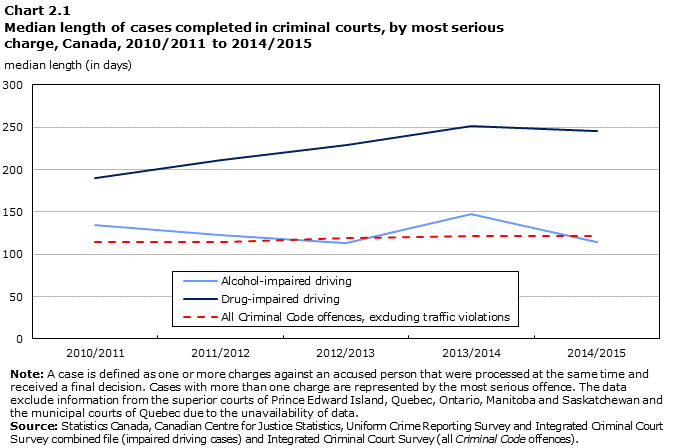
Description for Chart 2.1
| Year | Alcohol-impaired driving | Drug-impaired driving | All Criminal Code offences, excluding traffic violations |
|---|---|---|---|
| median length (in days) | |||
| 2010/2011 | 134 | 190 | 115 |
| 2011/2012 | 123 | 211 | 115 |
| 2012/2013 | 113 | 230 | 119 |
| 2013/2014 | 148 | 252 | 122 |
| 2014/2015 | 114 | 245 | 121 |
|
Note: A case is defined as one or more charges against an accused person that were processed at the same time and received a final decision. Cases with more than one charge are represented by the most serious offence. The data exclude information from the superior courts of Prince Edward Island, Quebec, Ontario, Manitoba and Saskatchewan and the municipal courts of Quebec due to the unavailability of data. Source: Statistics Canada, Canadian Centre for Justice Statistics, Uniform Crime Reporting Survey and Integrated Criminal Court Survey combined file (impaired driving cases) and Integrated Criminal Court Survey (all Criminal Code offences). |
|||
The difference in processing time between alcohol-impaired driving cases and drug-impaired driving cases was also due in part to the latter requiring more appearances.
For the period from 2010/2011 to 2014/2015, cases involving alcohol-impaired driving required an average of five appearances, while cases of drug-impaired driving required an average of seven appearances. However, looking at only cases that required at least five appearances, the median processing time for alcohol-impaired driving cases was actually longer than that for drug-impaired cases (359 days compared with 316 days).
The difference in processing time between alcohol- and drug-impaired driving cases varied from one jurisdiction to another. The difference was quite substantial in Prince Edward Island, Nova Scotia and Saskatchewan, the three jurisdictions with the shortest median time for alcohol-impaired driving cases at the provincial level (Chart 2.2).
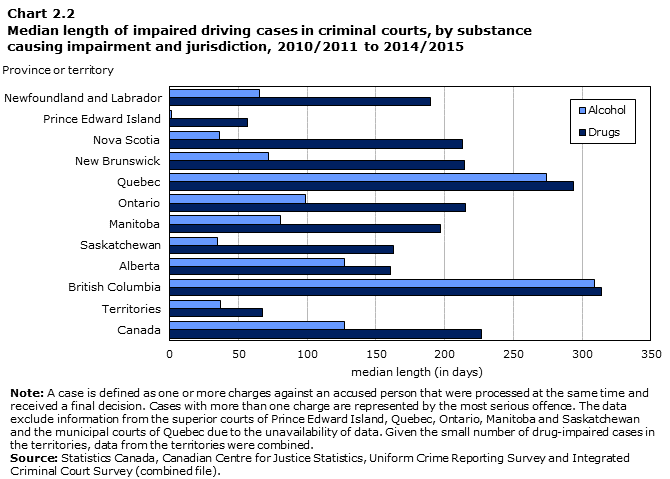
Description for Chart 2.2
| Province or territory | Drugs | Alcohol |
|---|---|---|
| median length (in days) | ||
| Canada | 227 | 127 |
| Territories | 68 | 37 |
| British Columbia | 314 | 309 |
| Alberta | 161 | 127 |
| Saskatchewan | 163 | 35 |
| Manitoba | 197 | 81 |
| Ontario | 215 | 99 |
| Quebec | 294 | 274 |
| New Brunswick | 215 | 72 |
| Nova Scotia | 213 | 36 |
| Prince Edward Island | 57 | 1 |
| Newfoundland and Labrador | 190 | 66 |
|
Note: A case is defined as one or more charges against an accused person that were processed at the same time and received a final decision. Cases with more than one charge are represented by the most serious offence. The data exclude information from the superior courts of Prince Edward Island, Quebec, Ontario, Manitoba and Saskatchewan and the municipal courts of Quebec due to the unavailability of data. Given the small number of drug-impaired cases in the territories, data from the territories were combined. Source: Statistics Canada, Canadian Centre for Justice Statistics, Uniform Crime Reporting Survey and Integrated Criminal Court Survey (combined file). |
||
In contrast, there was very little difference in QuebecNote 10 and in British Columbia, the two jurisdictions posting the highest median processing times for both alcohol-impaired and drug-impaired driving cases. In the case of British Columbia, it may be that only the more complex cases were heard by courts, while most other cases of alcohol-impaired driving were dealt with under the Motor Vehicle Act (see Text box 2).
Just over 6 in 10 drug-impaired driving cases result in a guilty verdict
Cases of drug-impaired driving are less likely to result in a guilty finding than cases of alcohol-impaired driving. In the five-year period reviewed, just over 6 in 10 drug-impaired driving cases (61%) resulted in a guilty verdict, whether by decision or by plea, a proportion very similar to that noted for all court-related cases (63%). In contrast, a little more than 8 in 10 (81%) cases where alcohol-impaired driving was the primary offence resulted in a guilty finding (Chart 2.3).
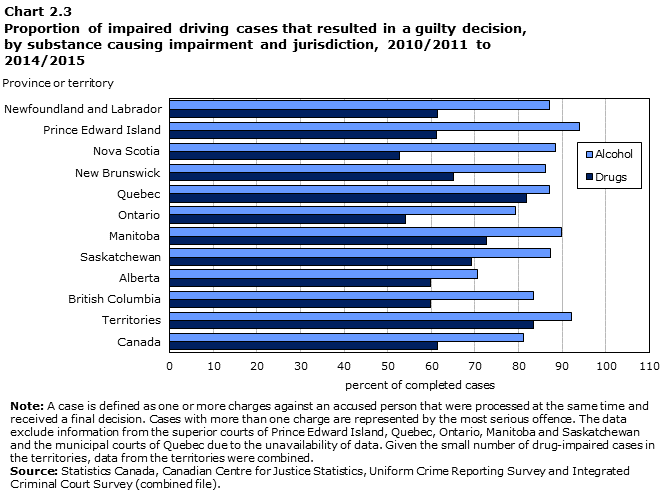
Description for Chart 2.3
| Province or territory | Drugs | Alcohol |
|---|---|---|
| percent of completed cases | ||
| Canada | 61.3 | 81.2 |
| Territories | 83.3 | 92.2 |
| British Columbia | 59.9 | 83.5 |
| Alberta | 59.9 | 70.5 |
| Saskatchewan | 69.2 | 87.3 |
| Manitoba | 72.7 | 89.7 |
| Ontario | 54.0 | 79.3 |
| Quebec | 81.9 | 87.1 |
| New Brunswick | 65.0 | 86.2 |
| Nova Scotia | 52.7 | 88.5 |
| Prince Edward Island | 61.1 | 94.0 |
| Newfoundland and Labrador | 61.4 | 87.0 |
|
Note: A case is defined as one or more charges against an accused person that were processed at the same time and received a final decision. Cases with more than one charge are represented by the most serious offence. The data exclude information from the superior courts of Prince Edward Island, Quebec, Ontario, Manitoba and Saskatchewan and the municipal courts of Quebec due to the unavailability of data. Given the small number of drug-impaired cases in the territories, data from the territories were combined. Source: Statistics Canada, Canadian Centre for Justice Statistics, Uniform Crime Reporting Survey and Integrated Criminal Court Survey (combined file). |
||
Drug-impaired driving cases resulted in an acquittal in 3.8% of cases, a proportion similar to that for alcohol-impaired driving (3.3%). Drug-impaired driving cases were, however, more likely than alcohol-impaired driving cases to end in a withdrawal, dismissal or discharge (25% compared with 12%) or by a stay of proceeding (8.9% compared with 3.3%).
This difference in the proportion of cases resulting in a guilty finding varied from jurisdiction to jurisdiction. For example, it was highest in the Atlantic provinces and Ontario and much lower in Quebec, the Territories and Alberta.
Fine, seizure order or prohibition order are the most commonly imposed sentences
Over the five-year period, the sentences most often imposed in impaired driving cases were a fine or prohibition order, in about 9 out of 10 cases for both alcohol-impaired driving and drug-impaired driving (Chart 2.4). Given that both of these offences carry a minimum sentence of a $1,000 fine and a one-year driving ban, it could be expected that they would be the ones most often imposed.
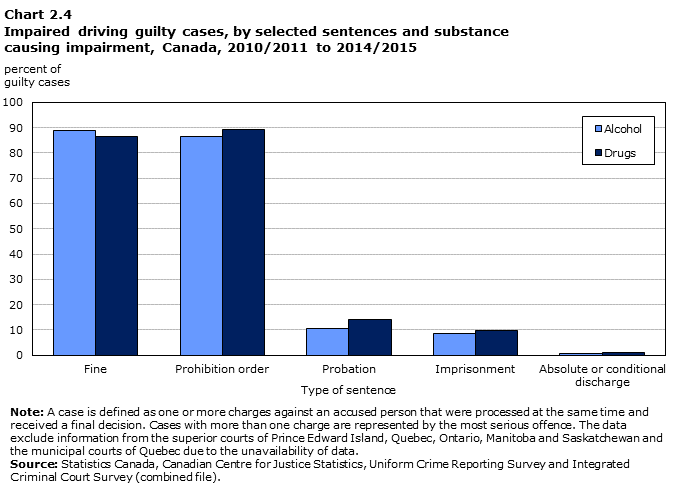
Description for Chart 2.4
| Type of sentence | Fine | Prohibition order | Probation | Imprisonment | Absolute or conditional discharge |
|---|---|---|---|---|---|
| percent of guilty cases | |||||
| Alcohol | 89.0 | 86.4 | 10.6 | 8.7 | 0.7 |
| Drugs | 86.6 | 89.2 | 14.2 | 9.8 | 1.2 |
|
Note: A case is defined as one or more charges against an accused person that were processed at the same time and received a final decision. Cases with more than one charge are represented by the most serious offence. The data exclude information from the superior courts of Prince Edward Island, Quebec, Ontario, Manitoba and Saskatchewan and the municipal courts of Quebec due to the unavailability of data. Source: Statistics Canada, Canadian Centre for Justice Statistics, Uniform Crime Reporting Survey and Integrated Criminal Court Survey (combined file). |
|||||
Fines for drug-impaired driving are on average slightly lower than those for alcohol-impaired driving
On average, drug-impaired driving cases resulting in a fine between 2010/2011 and 2014/2015 involved slightly lower fines than alcohol-impaired driving cases. The average fine for drug-impaired driving was $1,155 compared with an average of $1,240. More specifically, fines exceeded $1,000 in close to 6 in 10 alcohol-impaired driving cases (55%) compared with about 4 in 10 (40%) drug-impaired driving cases (Chart 2.5).
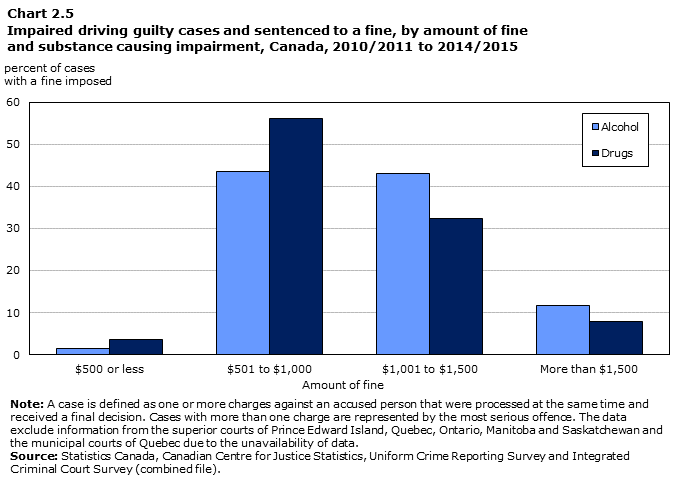
Description for Chart 2.5
| Amount of fine | Alcohol | Drugs |
|---|---|---|
| percent of cases with a fine imposed |
||
| $500 or less | 1.5 | 3.6 |
| $501 to $1,000 | 43.6 | 56.2 |
| $1,001 to $1,500 | 43.1 | 32.4 |
| More than $1,500 | 11.8 | 7.8 |
|
Note: A case is defined as one or more charges against an accused person that were processed at the same time and received a final decision. Cases with more than one charge are represented by the most serious offence. The data exclude information from the superior courts of Prince Edward Island, Quebec, Ontario, Manitoba and Saskatchewan and the municipal courts of Quebec due to the unavailability of data. Source: Statistics Canada, Canadian Centre for Justice Statistics, Uniform Crime Reporting Survey and Integrated Criminal Court Survey (combined file). |
||
About six in ten (58%) custody sentences for drug-impaired driving were for periods of less than 31 days, excluding the time that may have been spent in pre-trial detention (remand). In comparison, this was the case for 51% of prison sentences for alcohol-impaired driving.Note 11
A number of factors can influence the sentence or sentences imposed. Judges are required to take into consideration the key principles for sentencing such as the seriousness of the offence, the damages caused and the accused’s history. The Criminal Code also sets heavier minimum sentences in repeat cases of impaired driving, notably jail time.
Start of text box
Text box 4
Cases involving impaired drivers with a previous impaired driving record
Given the limitations of the administrative data provided to the Canadian Centre for Justice Statistics, the Integrated Criminal Court Survey, like the Uniform Crime Reporting Survey, does not measure recidivism in its truest sense. This is due to several factors, for one not all repeat offending is brought to the attention of the justice system. In addition, we do not have complete coverage of the country’s criminal courts, and our current methods of data collection limit our ability to identify when the same individual has been accused of crime in multiple jurisdictions, over time.
However, it can generally be determined whether a given person has appeared in court, in more than one case, in the same jurisdiction. We call these subsequent contacts, or re-contacts.
Among those accused of impaired driving whose cases were handled by the criminal courts in 2014/2015, at least 16% had been charged in a previous impaired driving case within the past 10 years in the same jurisdiction, regardless of whether or not they had been found guilty. Moreover, cases of impaired driving causing death or bodily harm were more likely (20%) to involve an accused who had prior contact with the courts for an impaired driving offence. The same trend was observed in cases where the accused refused to provide a breath, urine or blood sample (21%).
Overall, men (17%) were more likely than women (11%) to be back in contact with the courts for impaired driving.
Cases where the accused had prior contact with the courts were generally more complex than cases in which it was the accused’s first contact. On average, the cases involving re-contact required more court appearances and took longer to be processed by the courts.
Specifically, in 2014/2015, cases in which it was the accused’s first contact required a median number of four court appearances and a median processing time of 78 days. By comparison, it took a median number of six court appearances and a median of 198 days to process cases involving an accused with prior contact with the criminal courts. Furthermore, the complexity of impaired driving cases seemed to increase with the number of contacts the accused had with the courts for the same type of offence. Cases involving an accused with at least two prior contacts required a median number of seven court appearances and 216 days to process.
The differences in the number of court appearances and the time to process impaired driving cases can be explained in part by the fact that cases of re-contact for the same type of offence were more likely to involve multiple charges. In fact, 43% of cases involving an accused who had prior contacts comprised three or more charges. This proportion rose to 58% for cases in which the accused had at least two prior contacts. By comparison, less than one-quarter (24%) of cases involving an accused with no prior contact with the courts for impaired driving comprised three or more charges.
End of text box
Section 3: Self-reported drinking and driving in Ontario, Manitoba, Alberta, Yukon and Nunavut
As part of the 2014 Canadian Community Health Survey (CCHS), Ontario, Manitoba, Alberta, Yukon and Nunavut residents were asked questions about their automobile driving.Note 12Note 13 In particular, respondents were asked if they had driven a vehicle after consuming two or more alcoholic beverages in the hour before driving.
It should be noted that a person’s blood alcohol level can vary based on a number of factors and only a test conducted by a police officer and/or a screening device can determine whether a driver is actually impaired as per the Criminal Code. A person who has consumed two drinks in the hour before driving does not necessarily have a blood alcohol level above 80 mg/100 ml, although it is very likely to exceed the limits set by the traffic codes of most provinces. As such, the term “drinking and driving” is used in this section to designate driving after consuming at least two drinks in the hour before driving. For the sake of conciseness, the term “impaired” is also used in the same sense.
In 2014, respondents were asked about driving both an on-road vehicle—for example a car, sport utility vehicle (SUV), van or truck—and driving an off-road vehicle, such as a snowmobile, seadoo, boat or all-terrain vehicle (ATV). Whereas driving any type of vehicle while impaired is an offence under section 253 of the Criminal Code, the analysis that follows deals primarily with impaired driving of on-road vehicles.
One driver in 20 has driven after drinking
In 2014, just under 1 in 20 drivers (4.3%)Note 14 surveyed in select jurisdictions reported having driven an on-road vehicle after consuming two or more drinks in the hour before driving and that this occurred at least once in the 12 months before the survey. This proportion varied from 3.5% in Ontario to 9.1% in the Yukon (Chart 3.1).
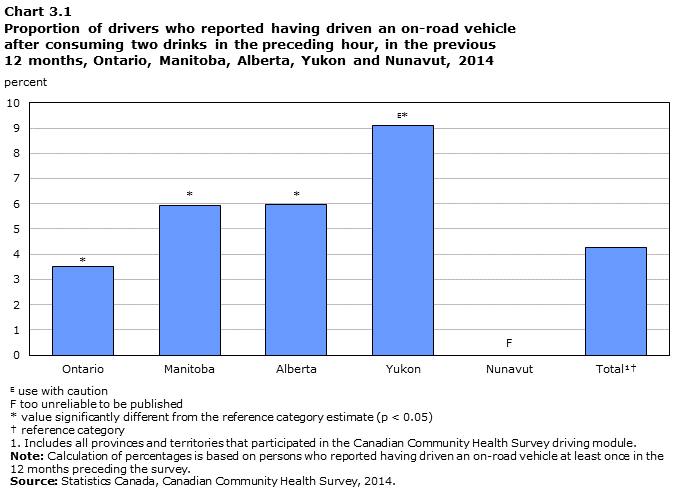
Description for Chart 3.1
| Province or territory | Percent |
|---|---|
| Ontario | 3.5Note * |
| Manitoba | 5.9Note * |
| Alberta | 6,0Note * |
| Yukon | 9.1Note E: Use with caution Note * |
| Nunavut | F |
| TotalData table Note 1 Data table Note † | 4.3 |
|
E use with caution F too unreliable to be published
Source: Statistics Canada, Canadian Community Health Survey, 2014. |
|
Residents of Ontario, Alberta and the Yukon had also been asked about their driving in the 2009 CCHS. That year, 5.6% of drivers in these three provinces or territories had reported driving an on-road vehicle after drinking, a higher proportion than recorded in 2014 (4.1%).
A similar proportion (4.9%) of people who had driven a snowmobile, seadoo, ATV or motor boat also reported driving such vehicles after drinking.
In total, about 640,000 residents of Ontario, Manitoba, Alberta, Yukon or Nunavut, or 5% of those who had driven any type of motor vehicle, had driven after drinking at least once during the period covered by the survey.
Most of those who did drink and drive did so more than once
While a minority of drivers reported having driven an on-road vehicle at least once while impaired in the 12 months preceding the survey, the majority of those individuals who did drink and drive did so more than once. In fact, about three-quarters (76%) of impaired drivers stated that they had driven after having consumed two or more drinks in the hour before driving at least twice in the year, and 1 in 10 reported having done so more than 10 times (Chart 3.2).
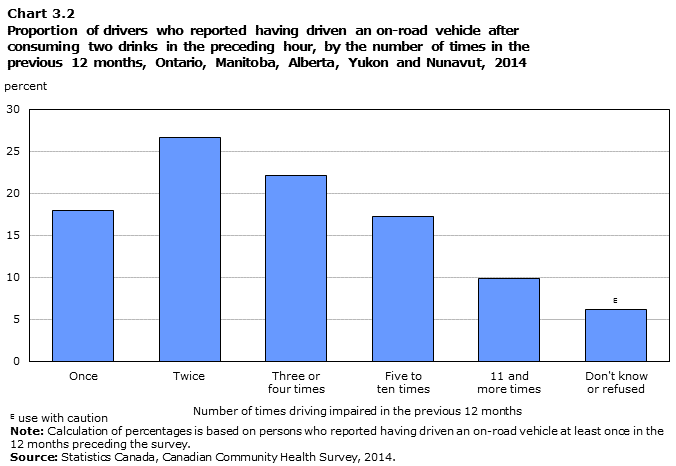
Description for Chart 3.2
| Number of times driving impaired in the previous 12 months | Percent |
|---|---|
| Once | 17.9 |
| Twice | 26.6 |
| Three or four times |
22.1 |
| Five to ten times |
17.3 |
| 11 and more times |
9.8 |
| Don't know or refused |
6.2Note E: Use with caution |
|
E use with caution Note: Calculation of percentages is based on persons who reported having driven an on-road vehicle at least once in the 12 months preceding the survey Source: Statistics Canada, Canadian Community Health Survey, 2014. |
|
On average, impaired drivers reported 6 occurrences of driving an on-road vehicle after drinking in the 12 months before the survey. In total, that represents almost 3 million incidents of drinking and driving, 97% of which were caused by repeat offenders. In comparison, police reported a total of 32,869 incidents of impaired driving in Ontario, Manitoba, Alberta, Yukon and Nunavut in 2014.
Many impaired drivers reported also having driven an off-road vehicle after drinking. Among those who had driven an on-road vehicle after drinking and had driven an off-road vehicle, more than one-quarter (29%) stated that they had driven an off-road vehicle after drinking at least once in the previous 12 months.
As many impaired drivers in CMAs as in regions outside CMAs
Contrary to what was observed from police-reported data, the CCHS data from select jurisdictions indicate that similar proportions of drivers of on-road vehicles drove while impaired in CMAs as in regions outside CMAs, specifically 4.1% and 4.7% respectively (Chart 3.3).
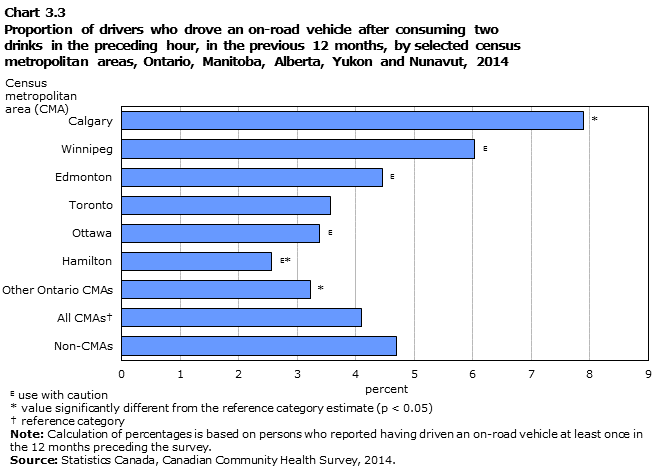
Description for Chart 3.3
| Census metropolitan area (CMA) | Percent |
|---|---|
| Non-CMAs | 4.7 |
| All CMAsData table Note † | 4.1 |
| Other Ontario CMAs | 3.2 |
| Hamilton | 2.6Note E: Use with caution Note * |
| Ottawa | 3.4Note E: Use with caution |
| Toronto | 3.6 |
| Edmonton | 4.5Note E: Use with caution |
| Winnipeg | 6,0Note E: Use with caution |
| Calgary | 7.9Note * |
E use with caution
Source: Statistics Canada, Canadian Community Health Survey, 2014. |
|
These results support the premise that part of the difference between CMA and non-CMAs observed from the police data is due to rates being calculated per total population as opposed to per driving population. Indeed, CCHS data shows that residents of regions outside CMAs were, in fact, more likely to have driven a vehicle in the previous year than those within the CMAs (87% compared with 77%).
The police-reported rates, however, also include impaired driving of off-road vehicles such as ATVs, snowmobiles or motor boats. When impaired driving of an off-road vehicle is included, a higher proportion of residents of regions outside CMAs have driven a motor vehicle (all types) while impaired than residents of CMAs (5.9% compared with 4.7%).
The majority of drivers who reported drinking and driving are men
The majority (91%) of drivers who reported having driven an on-road vehicle after consuming two drinks in the hour before driving were men. About 1 in 13 men (7.5%) had driven impaired compared with fewer than 1 in 100 women (0.8%) (Table 3.1).
Not only were men more likely than women to report having driven impaired but, on average, they were also more likely to have done so more often. Men who had driven impaired in the 12 months before the survey had done so on average 6 times, compared with 4 times for women.
This difference between males and females is slightly greater than the difference observed in police-reported data. However, it should be noted that the same quantity of alcohol will affect people differently depending on various factors, including sex (Educ’alcool 2016).
Young adults more likely to report drinking and driving but older adults more likely to do so more than once
Overall, young adults were the most likely to report having driven an on-road vehicle after drinking in 2014. Almost 4 in 10 impaired drivers were between 18 and 34 years, although this age group represents only 28% of drivers.
More specifically, drivers between the ages of 25 and 34 were most likely (6.4%) to report impaired driving of an on-road vehicle. This proportion falls slowly as the age advances, to 2.7% among drivers aged 65 and older (Chart 3.4 and Table 3.1).
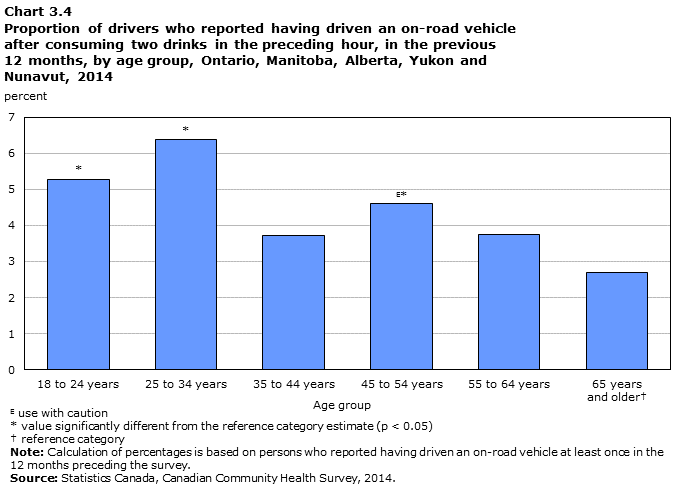
Description for Chart 3.4
| Age group | Percent |
|---|---|
| 18 to 24 years | 5.3Note * |
| 25 to 34 years | 6.4Note * |
| 35 to 44 years | 3.7 |
| 45 to 54 years | 4.6Note E: Use with caution |
| 55 to 64 years | 3.7 |
| 65 years and olderData table Note † |
2.7 |
E use with caution
Source: Statistics Canada, Canadian Community Health Survey, 2014. |
|
However, older drivers who had driven after drinking were more likely to have done so more than once. On average, drivers aged 18 to 34 who had driven an on-road vehicle after two drinks in the hour before driving did so 5 times in the 12 months before the survey, compared with 8 times for those 55 to 64 and 7 times for those 65 and older.
The majority of drivers who reported drinking and driving belong to higher income quintiles
In 2014, drivers with high household incomes were more likely than drivers with lower incomes to report having driven after drinking at least once in the 12 months before the survey.
Almost two-thirds (64%) of impaired drivers were from the top two income quintiles.Note 15 Drivers in the top quintile were almost three times more likely than those in the bottom quintile to report having driven after drinking (6.1% compared with 2.2%E) (Table 3.1).
Excessive consumption of alcohol is more closely linked to drinking and driving than the frequency of consumption
Higher proportions of impaired drivers were observed among drivers who reported drinking daily (10%) or at least once a week but not daily (10.5%) than among drivers who reported drinking once or less per month (0.4%) (Table 3.2).
The highest proportion of impaired drivers was noted among those who reported excessive drinking—that is, 5 drinks or more for men and 4 drinks or more for women on a single occasion—at least once a week (20.7%). These drivers represented 7% of drivers but 32% of drivers who did drink and drive.
When excessive drinking was taken into account, frequency had very little impact. In other words, a person who drank frequently but moderately was no more likely to drive impaired than the average.
Drivers reporting drinking and driving are less likely to have healthy lifestyles
In 2014, persons who reported driving after having at least two drinks in the hour before driving were less likely to report having healthy lifestyles than those who did not drink and drive. A healthy lifestyle refers to adopting behaviours conducive to health such as not smoking, eating healthy foods, drinking in moderation or playing sports during leisure time.
The previous section already addressed the consumption of alcohol by impaired drivers but they were also more likely to smoke and to eat fewer fruits and vegetables.
One-third (34%) of impaired drivers were smokers, a proportion two times higher than drivers who had not driven after drinking (17%). Smokers were in fact particularly more likely to consume alcohol excessively: 33% of them reported drinking excessively at least once a month compared with 16% of drivers who had never smoked.
Consumption of fruits and vegetables is another indicator of healthy lifestyles, being associated with smoking habits, alcohol dependence and level of physical activity (Pérez 2002). Drivers who reported drinking and driving were less likely to eat fruits and vegetables regularly, with 43% reporting eating fewer than three portions per day, a proportion close to twice as high as that noted among drivers who had not driven after drinking (24%).
Playing team sports is associated with a higher probability of drinking and driving
Although healthy lifestyles are generally associated with a lower probability of drinking and driving, playing sports during leisure time was the exception to this rule.
The data from the 2014 CCHS reveal that there were similar proportions of impaired drivers who were inactive, moderately active and active (Table 3.2). However, people who reported playing a team sport in the three months before the survey—hockey, baseball, softball, volleyball, basketball or soccer—were almost twice as likely as inactive persons to report driving after drinking at least two drinks in the hour before driving (7.3% compared with 3.9%).
Although playing individual sports was usually not associated with drinking and driving, there were a few exceptions. Of note, people who reported playing golf (10%), skiing or snowboarding (8.5%E), bowling (7.1%) or fishing (7.9%) were also more likely than inactive individuals to report driving after drinking at least two drinks in the hour before driving.
Speeding and aggressive driving are linked to impaired driving
In addition to asking respondents about their drinking and driving experiences, the CCHS gathered information on other at-risk driving behaviours. In particular, respondents were asked if they believed they drove faster or more aggressively than the average, as well as how often they fastened their seat belt. A number of studies have shown a strong correlation between impaired driving and at-risk behaviours (Zuckerman and Kuhlman 2000; Jonah 1997).
Almost one-quarter (24%) of drivers reported driving faster than the average. Of these respondents, 7.7% reported drinking and driving compared with 2.9%E of drivers who reported driving slower than the average (Table 3.2).
A slightly lower proportion of drivers reported driving more aggressively than the average (14%), but they were also more likely to report having driven after drinking than drivers driving less aggressively than the average (9.2% compared with 2.9%).
Not wearing a seat belt is another at-risk behaviour associated with impaired driving. The vast majority (95%) of drivers reported always fastening their seat belt. However, among those for whom this was not the case, 14% reported having driven after drinking.
A minority of drivers reported never driving when tired
Like alcohol, fatigue affects the ability to drive. Fatigue is even ranked third among causes of car accidents after alcohol and dangerous driving (Canada Safety Council 2009). Moreover, the effect of fatigue, combined with drinking alcohol or taking drugs, can lead to impaired driving charges under the Criminal Code even if the blood alcohol level is below 80 mg/100 ml (Royal Canadian Mounted Police 2016b).
According to the CCHS, few drivers reported never driving when they felt tired. This was the case for less than one-third (32%) of drivers in 2014. An additional approximately one-third (36%) reported that it occurred seldom, while 23% stated that it occurred sometimes and 9% said it occurred often (Chart 3.5).
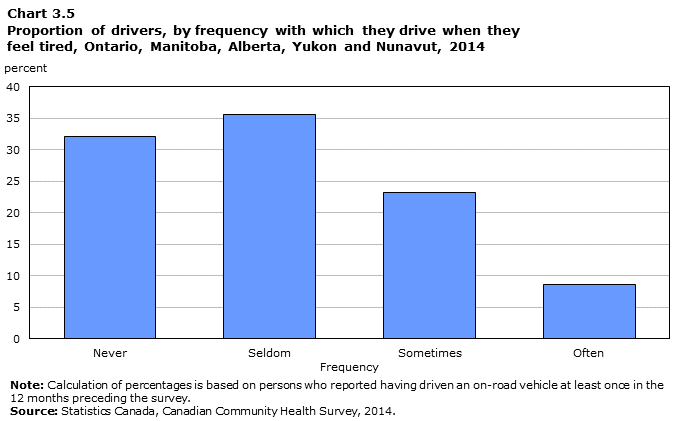
Description for Chart 3.5
| Frequency | Percent |
|---|---|
| Never | 32.1 |
| Seldom | 35.6 |
| Sometimes | 23.3 |
| Often | 8.6 |
|
Note: Calculation of percentages is based on persons who reported having driven an on-road vehicle at least once in the 12 months preceding the survey. Source: Statistics Canada, Canadian Community Health Survey, 2014. |
|
CCHS respondents were not asked during the survey if they were tired when they had driven after drinking. However, the data reveal that persons reporting often driving when feeling tired were about 6 times more likely than persons who never drive when feeling tired to report having driven after drinking at least once in the 12 months before the survey (8.8% compared with 1.4%).
More than one-quarter of car drivers have used a cell phone while driving
Distracted driving is a growing road safety issue. It is estimated that distracted driving played a role in 23% of fatal accidents and 27% of accidents with injuries in 2012, and that these numbers have increased by 26% and 14% respectively since 2006 (Robertson, Bowman and Charles 2015). In some provinces, distracted driving has reportedly been the cause of even more car accidents than impaired driving (Robertson, Bowman and Charles 2015).
While distracted driving can refer to a multitude of behaviours (e.g., reading, eating, using GPS, watching a video or talking to passengers) it is generally admitted that using a cell phone, especially without a hands-free device, is currently the main cause of distracted driving. Most provinces have therefore adopted laws prohibiting this use (Royal Canadian Mounted Police 2016c; Robertson, Bowman and Charles 2015).
According to the CCHS data, more than one-quarter (27%) of drivers reported using a cell phone while driving.Note 16 Few drivers (3%), or about 423,000 drivers in Ontario, Manitoba, Alberta, Yukon and Nunavut, reported doing so often (Chart 3.6).
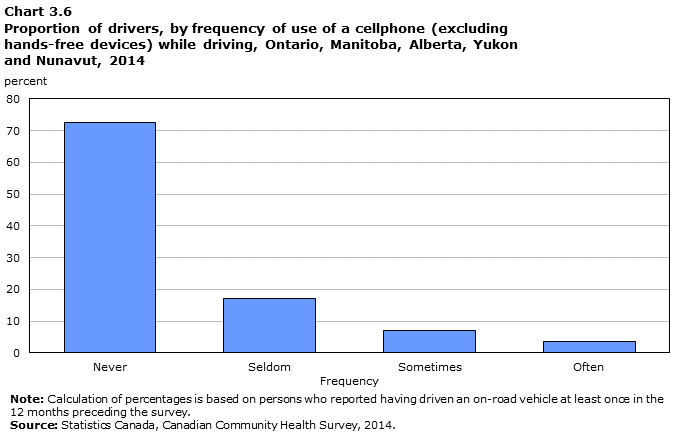
Description for Chart 3.6
| Frequency | Percent |
|---|---|
| Never | 72.5 |
| Seldom | 17.0 |
| Sometimes | 7.0 |
| Often | 3.4 |
|
Note: Calculation of percentages is based on persons who reported having driven an on-road vehicle at least once in the 12 months preceding the survey. Source: Statistics Canada, Canadian Community Health Survey, 2014. |
|
Drivers aged 18 to 34 were more likely to report using a cell phone while driving, this being the case for almost half (45%) of them. Males (32%) were also slightly more likely than females (23%) to report using a cell phone while driving.
Like speeding and aggressive driving, using a cell phone while driving is a behaviour linked to drinking and driving. Almost 1 in 10 drivers who stated that they had used a cell phone while driving at least sometimes also reported having driven an on-road vehicle after consuming at least two drinks in the hour before driving and doing so at least once in the 12 months before the survey compared with 2% of those stating they never use a cell phone while driving (Table 3.2).
Start of text box
Text box 5
Multivariate analysis of impaired driving
As the previous sections have illustrated, many characteristics are associated to varying degrees with drivers who reported drinking and driving.
Sometimes, certain characteristics can be interrelated. For example, larger proportions of young adults reported having driven after drinking. However, larger proportions of young people also stated they had adopted certain at-risk driving behaviours such as speeding.
Therefore, is drinking and driving linked to being young or to having at-risk driving behaviours? Would an older adult with at-risk driving behaviours also be more likely to drink and drive? A multivariate analysis can be used to answer these types of questions by evaluating each of the measured factors while holding the other characteristics constant.
Since drinking and driving is closely linked to the consumption of alcohol, two analytical models were created: the first excluding drinking behaviour (Model 1) and the other including it (Model 2). The first model should be understood as evaluating the probability of alcohol consumption leading to impaired driving, while the second would measure the factors linked to making the decision to drive after drinking.
The logistic regression results (multivariate analysis) indicate that the majority of characteristics associated with drinking and driving, presented in the previous sections and Table 3.1 and Table 3.2, remain associated with drinking and driving even when all factors are taken into consideration.
However, there are a few notable exceptions. In particular, the relationship by age is reversed. Proportionately more young people than older adults reported having driven after drinking. However, when other factors are considered, adults aged 65 and older were more than 4 times more likely than youth 15 to 24 to report drinking and driving (Model 2). In other words, between a young adult and an older adult, both with the same drinking habits and driving habits, the older adult would be more likely to make the decision to drive after drinking.
Among the other exceptions, being a smoker was no longer a factor when all other factors, including alcohol consumption, were taken into account. The same holds true for aggressive driving. However, it should be noted that drivers seem to play down their aggressive driving, since 41% of drivers report being less aggressive than the average, and only 14% state that they are more aggressive than the average. This could slightly bias the results.
End of text box
Almost 1 in 10 people have been a passenger of driver who had drank
According to the CCHS, in 2014, 8% of residents aged 15 and older in Ontario, Manitoba, Alberta, Yukon and Nunavut reported being passengers of a driver who had had at least two drinks in the hour before getting behind the wheel (Table 3.3).
In cases where passengers themselves are also intoxicated, the risk of an accident can even be amplified (Beirness 2014). Some countries, notably Japan (Educ’alcool 2010), have put in place enforcement measures for passengers of impaired drivers.
Moreover, there may also be a link between being a passenger of an impaired driver and driving impaired oneself (Yu and Shacket 1999). According to the CCHS, more than one-quarter (27%)Note 17 of passengers of impaired drivers reported also having driven a vehicle themselves while impaired. More than half (59%) of impaired drivers stated that they had also been passengers of an impaired driver in the 12 months before the survey.
In general, the characteristics of impaired drivers and those of passengers were relatively similar. For example, young adults, individuals who reported driving faster or more aggressively than the average and individuals who reported consuming alcohol excessively at least once a month were all more likely than the average to have been passengers of a driver who had drank.
Some differences observed in drinking and driving were somewhat less pronounced for passengers of an impaired driver. For example, while men were about nine times more likely than women to report having driven after consuming at least two drinks in the hour before driving, they were 1.7 times more likely to report having been passengers of an impaired driver.
Finally, in many cases, being a driver or passenger may depend more on circumstances—such as being the one with the car—than on the characteristics of the people involved, since attitudes toward at-risk behaviours and alcohol consumption among impaired drivers and their passengers are relatively similar (Beirness 2014).
Summary
In 2014, about 4% of drivers in Ontario, Manitoba, Alberta, Yukon and Nunavut reported driving in the previous 12 months after consuming at least two drinks in the hour before driving. More than three-quarters of them said they had done so more than once in the year. Altogether, these drivers who reported drinking and driving more than once were responsible for 97% of drinking and driving incidents.
In 2015, police reported 72,039 impaired driving incidents nationally, or a rate of 201 incidents per 100,000 population, the lowest rate reported since data on this were first collected in 1986. Drug-impaired driving accounted for about 4% of these incidents, a proportion that has been rising steadily since a distinction was first made between alcohol-impaired driving and drug-impaired driving in 2009.Note 18
Overall, police-reported impaired driving rates were higher in the Territories, Saskatchewan and Alberta and lower in Ontario and Quebec. Impaired driving rates were also higher outside CMAs but, based on self-reported data from the CCHS, this difference is likely related to differences in the proportion of people driving vehicles and to the proportion driving an off-road vehicle (such as a boat or ATV) while impaired.
Police-reported impaired driving was highest among young adults in 2015. However, it is also among young people that the most substantial decline in impaired driving has occurred in recent years. Furthermore, the CCHS data show that drinking and driving was more associated with factors, such as driving behaviours and drinking habits, than age itself, as young people were less likely to report drinking and driving than older adults when other factors were taken into account.
About 70% of police-reported impaired driving incidents in 2015 resulted in charges under the Criminal Code. Drug-impaired driving incidents were less likely to result in a charge than alcohol-impaired driving incidents. When heard by the courts, drug-impaired cases, overall, took more than double the time to be processed, a gap that has widened since data were first collected on this subject. In addition, drug-impaired driving cases were less likely than alcohol-impaired driving cases to result in a guilty finding.
Start of text box
Text box 6
Recent Juristat articles dealing with impaired driving
End of text box
Survey description
Uniform Crime Reporting Survey (UCR)
The UCR Survey was developed in 1962 with the cooperation and assistance of the Canadian Association of Chiefs of Police. The UCR Survey data reflect reported crime that has been substantiated through a police investigation. The data come from all federal, provincial and municipal police services in Canada and involve offences under the Criminal Code and other federal statutes.
One incident can involve multiple offences. To ensure the comparability of the data between police services, the counts presented in this article are based on the most serious offence in the incident, determined based on a standardized classification rule used by all police services. One incident can involve both alcohol-impaired driving and drug-impaired driving, which are equally serious offences. In these cases, the analysis deals with what the police determined to be the primary offence.
Integrated Criminal Court Survey (ICCS)
The ICCS is administered by the Canadian Centre for Justice Statistics (Statistics Canada) in collaboration with provincial and territorial departments responsible for criminal courts in Canada. The survey collects statistical information on adult and youth court cases involving Criminal Code and other federal statute offences.
The primary unit of analysis is a case. A case is defined as one or more charges against an accused person or company that were processed by the courts at the same time and received a final decision. A case combines all charges against the same person having one or more key overlapping dates (date of offence, date of initiation, date of first appearance, date of decision, or date of sentencing) into a single case.
In 2014/2015, the ICCS covered all cases completed by Canadian adult criminal courts except the superior courts of Prince Edward Island, Quebec, Ontario, Manitoba and Saskatchewan, as well as the municipal courts of Quebec. These data could not be extracted from the electronic information systems of these provinces and, consequently, were not reported to the survey.
Combined file of the Integrated Criminal Court Survey and Uniform Crime Reporting Survey
For this report, the data from the ICSS and the UCR were combined to distinguish between cases of alcohol-impaired driving and drug-impaired driving.
The first step was to identify, for 2010/2011 to 2014/2015, all cases completed by criminal courts for which the most serious charge was impaired driving. By using a process of deterministic hierarchical matching, we then tried to identify, among the incidents reported by police between 2008 and 2014, those that corresponded to impaired driving cases completed by the courts. It was possible to establish a reliable match for 185,667 cases, or 87% of impaired driving cases.
Canadian Community Health Survey (CCHS)
The CCHS is a cross-sectional survey of about 65,000 respondents that collects information related to health status, health care utilization and health determinants for the Canadian population. The CCHS contains some optional content including the automobile driving module. These optional modules are chosen by provincial and territorial stakeholders and apply only to the provinces and territories selecting the module. In 2014, this module applied to Ontario, Manitoba, Alberta, Yukon and Nunavut, for a total of about 32,000 respondents.
The CCHS covers the population 12 years of age and over living in the ten provinces and the three territories. Excluded from the survey's coverage are persons living on reserves and other Aboriginal settlements in the provinces, full-time members of the Canadian Forces, and the institutionalized population. The CCHS frame covered 92% of the target population of the Yukon and Nunavut.
Like all household surveys, the data have limitations. The results are based on a sample and are therefore subject to sampling errors. Slightly different results might have been obtained if the survey had covered the entire population. In this article, the coefficient of variation (c.v.) is used as the measure of sampling error. Any estimate with a high c.v. (more than 33.3%) was not published because it was too unreliable. In these cases, the charts and tables contain the symbol “F” rather than an estimate. When the c.v. of an estimate is between 16.6 and 33.3, the estimate should be used with caution and the symbol “E” is displayed. For descriptive statistics and cross-tabular analyses, confidence intervals of 95% were used to determine if the difference between the values was statistically significant.
Detailed data tables
Table 1.1 Impaired driving incidents, by type of offence and by province or territory, 2015
Table 1.2 Alcohol- or drug-impaired driving incidents, by census metropolitan area, 2015
References
Allen, M. 2016. “Police-reported crime statistics in Canada, 2015.” Juristat. Vol. 36, no. 1, Statistics Canada Catalogue no. 85-002-X.
Asbridge, M. and R. Ogilvie. 2015. A Feasibility Study of Roadside Oral Fluid Drug Testing. MADD Canada.
Beirness, D. J. 2014. The Characteristics of Youth Passengers of Impaired Drivers. Canadian Centre on Substance Abuse. Ottawa, Ontario.
Beirness, D. J. and E. E. Beasley. 2011. Alcohol and Drug Use Among Drivers, British Columbia Roadside Survey 2010. Canadian Centre on Substance Abuse. Ottawa, Ontario.
Canada Safety Council. 2009. “Driver fatigue: Falling asleep at the wheel.” Safety Canada. Vol. 53, no. 2. Ottawa, Ontario.
Canadian Centre on Substance Abuse (CCSA). 2015. “Drug evaluation and classification program.” Briefing Note. December.
Department of Justice Canada. 2016. Changing Marijuana Laws – Legalization and Regulation of Marijuana. (accessed August 12, 2016).
Educ’alcool. 2016. Drinking, Driving, Making the Right Choice. Montréal, Quebec. (accessed August 12, 2016).
Educ’alcool. 2010. Abus d’alcool au volant : Les effets de l’augmentation de la perception de se faire prendre si l’on conduit avec les facultés affaiblies. Montréal, Quebec.
Jonah, B. J. 1997. “Sensation seeking and risky driving: A review and synthesis of the literature.” Accident Analysis & Prevention. Vol. 29, no. 5.
Maxwell, A. 2015. “Adult criminal court statistics in Canada, 2013/2014.” Juristat. Vol. 35, no. 1. Statistics Canada Catalogue no. 85-002-X.
Paré, L. and M. Larochelle. 2004. “Alternatives de transport à la conduite avec facultés affaiblies en région rurale : bilan des perspectives.” Agence de Développement de Réseaux Locaux de Services de Santé et de Services Sociaux de Chaudières-Appalaches. Direction de santé publique.
Perez, C. E. 2002. “Fruit and vegetable consumption.” Health Reports. Vol. 13, no. 3, Statistics Canada Catalogue no. 82-003-X.
Public Safety Canada. 2011. “Drug-Impaired Driving – Trends, Enforcement and Prosecution.” Emerging Issues in Drug Enforcement Workshop. April 17th and 18th, Montreal, Quebec. Report prepared by Landsdowne Technologies Inc. (accessed August 12, 2016).
Robertson, R. D., Wicklund, C., Holmes, E. and P. Biderman. 2016. Impaired Driving in Rural Jurisdictions: Problems and Solutions. Traffic Injury Research Foundation. Ottawa, Ontario.
Robertson, R. D., Bowman, K. and J.-M. Charles. 2015. Distracted Driving in Canada: Making Progress, Taking Action. Traffic Injury Research Foundation. Ottawa, Ontario.
Royal Canadian Mounted Police (RCMP), Traffic Services. 2016a. Drug Recognition Expert. (accessed August 12, 2016).
Royal Canadian Mounted Police (RCMP), Traffic Services. 2016b. Five Things You Should Know About Impaired Driving. (accessed August 12, 2016).
Royal Canadian Mounted Police (RCMP), Centre for youth crime prevention. 2016c. Distracted Driving. (accessed August 12, 2016).
Senate Canada. 2016. “Delaying justice is denying justice. An urgent need to address lengthy court delays in Canada.” Report of the Standing Senate Committee on Legal and Constitutional Affairs. (accessed August 12, 2016).
Transport Canada. 2016. Canadian Motor Vehicle Traffic Collisions Statistics 2014. (accessed August 12, 2016).
Yu, J. and R.W. Shacket. 1999. “Drinking-driving and riding with drunk drivers among young adults: An analysis of reciprocal effects.” Journal of Studies on Alcohol. Vol. 60, no. 5. p. 615-621.
Zuckerman, M. and D. M. Kuhlman. 2000 “Personality and risk-taking: Common biosocial factors.” Journal of Personality. Vol. 68, no. 6. pp. 999-1029.
Notes
- Date modified:
